
THE LIVED EXPERIENCE OF LOW-INCOME SINGLE MOTHERS IN THE U.S. AND THE
EFFECTS OF NATURE AS A PSYCHOTHERAPEUTIC TOOL IN THEIR TREATMENT
A dissertation presented to the faculty of
ANTIOCH UNIVERSITY SANTA BARBARA
in partial fulfillment of
the requirements for the
degree of
DOCTOR OF PSYCHOLOGY
in
CLINICAL PSYCHOLOGY
By
Suzanne L. Frost
May, 2019

ii
THE LIVED EXPERIENCE OF LOW-INCOME SINGLE MOTHERS IN THE U.S. AND THE
EFFECTS OF NATURE AS A PSYCHOTHERAPEUTIC TOOL IN THEIR TREATMENT
This dissertation, by Suzanne L. Frost; has been approved by the committee members signed
below who recommend that it be accepted by the faculty of Antioch University Santa Barbara in
partial fulfillment of requirements for the degree of
DOCTOR OF PSYCHOLOGY
Dissertation Committee:
________________________________________________
Brett Kia-Keating, Ed.D.
Dissertation Chair
________________________________________________
Bella DePaulo, Ph.D
Second Faculty
________________________________________________
Thomas Doherty, PsyD,
External Expert

iii
© Suzanne L. Frost, 2019

iv
Abstract
This dissertation describes current research on the lived experience of low-income single
mothers and explores the potential validity of utilizing exposure to natural settings as a
psychotherapeutic intervention for this population. In 2014, 4,764,000 single mothers in the U.S.
were living in poverty. A large percentage of this population suffers from poverty, hunger,
social stigma, as well as mental illnesses associated with these conditions, such as anxiety, stress,
and depression. A qualitative influential research study was performed that included interviews
with eight low income White single mothers and one Biracial Turkish and Chaktau Native
American low-income single mother in predominantly rural Arizona. In these interviews,
participants were asked to describe both causes and mitigating factors in their lived experience of
being low-income single mother including the effects of regularly experiencing nature. Results
indicated predominant financial distress, physical and mental illnesses of mothers and children,
and social stigma and discrimination, as well as other lived experiences. All participants
currently or in the past had found developmental, physical, and mental benefits from nature
contact. Various successful ecotherapy self-care interventions and types of nature experiences
were reported by project participants and validated by ecotherapy research. A proposed model
of ecotherapy for low-income single mothers was theorized. Based on the results of this project,
recommendations for educational and policy change regarding this population and the promising
and often conclusive research on the efficacy of ecotherapy are presented. This dissertation is
available in open access at AURA: Antioch University Repository and Archive,
http://aura.antioch.edu and OhioLink ETD Center, http://www.ohiolink.edu/etd

v
Acknowledgments
This dissertation is dedicated to the many people who encouraged me to take this enriching
academic journey. I wish to thank my mother for making this road easier with her support, and
my dissertation committee members who were enthusiastic, supportive, and reliable. In
particular, I dedicate my dissertation and will always be grateful to the participants in my
research study who graciously volunteered to give their time and share their experiences with
honesty, kindness, and generosity. I wish to thank the many talented and inspiring professors
and staff in the clinical psychology doctoral program at Antioch in Santa Barbara who made
themselves available for consultation whenever I needed it, especially Dr. Ron Pilato’s support
and encouragement in my decision to perform a feminist research project on poverty in the U.S.
for my dissertation. I also wish to thank Stephanie Holland for her patience and kind service to
this doctoral program for many years. Lastly, I am also grateful to the professors with whom I
worked in the doctoral program in clinical psychology at Pacifica Graduate Institute before I
entered this program who first introduced me to this dynamic, transformative, and innovative
field.

vi
Table of Contents
List of Tables ................................................................................................................................. ix
List of Figures .................................................................................................................................x
Introduction..................................................................................................................................... 1
Literature Review............................................................................................................................ 4
Introduction ............................................................................................................................. 4
Systemic limitations of choice ................................................................................................ 4
Nature as a psychotherapeutic tool ......................................................................................... 5
Definition of “Single” ............................................................................................................. 6
Prejudice, Stigma, and Trends Regarding Single People in General ...................................... 6
Characteristics of Single Mothers ........................................................................................... 7
Child centrality........................................................................................................................ 8
Systemic challenges ................................................................................................................ 8
Stigma and single mothers .................................................................................................... 11
ௗFinancial Hardship and the Hunger of Low-Income Single Mothers .................................. 13
Food insufficiency ................................................................................................................ 14
Womanhood and motherhood wage penalties ...................................................................... 14
African-American single mothers......................................................................................... 16
Latina single mothers............................................................................................................ 17
Asian single mothers............................................................................................................. 18
White single, low-income mothers ....................................................................................... 18
Oppressive Social-Economic Environments and Reported Poor Mental Health of Low-
Income Single Mothers ..................................................................................................... 19
Environment.......................................................................................................................... 21
Physical health effects........................................................................................................... 21
Isolation and lack of social support ...................................................................................... 22
Potential Mitigating Factors and Intervention Strategies ...................................................... 22
The Effects of Nature on Mental Health ............................................................................... 24
Discussion ............................................................................................................................. 34
Method .......................................................................................................................................... 35
Interview Process and Protocol ............................................................................................. 35

vii
Recruitment Criteria and Data Collection ............................................................................. 36
Case Selection and Analyses Methodology .......................................................................... 39
Results........................................................................................................................................... 43
Question 1: What can you tell me about your life in general as a single woman with a child
(or children) living on a small income? ............................................................................ 43
Summary and interpretation of findings ............................................................................... 44
Description of the Qualitative Research Modalities that Were Used.................................... 45
Thoughts and Feelings of the Researcher and Overall Possible Researcher Biases ............. 48
Question 2: Where are you from originally? What town do you currently live in?............ 51
Question 3: How much education have you received (degrees, training?) ........................... 53
Question 4: How many children do you have? What age are they? Do you and your family
have any health issues that you feel comfortable sharing with me about? ....................... 58
Question 5: If you feel comfortable sharing, have you ever been married? How many
times? ................................................................................................................................ 58
Questions 6 and 7: If you are comfortable talking about it, what is your relationship with the
child or your children’s father like? Do you believe the relationship (or lack of
relationship) with the father of your child/children affect(s) you and how you parent?
How? In what ways? Can you give me an example?....................................................... 60
Question 8: Would it be okay with you to talk about your employment status? Part time?
Full time? Work from home? Unemployed? Are you happy with your employment
status? In what ways, if any, does being a single mother affect your employment status?
How about having low income? Do you think this affects your employment, and if so, in
what ways?........................................................................................................................ 62
Question 9: If you feel like talking about it, what has your experience regarding housing? Is
it or has it been stable?...................................................................................................... 64
Question 10: If you feel okay talking about it, what is your experience regarding finances?
........................................................................................................................................... 67
Effects of having low income................................................................................................ 68
Question 11: If you wish to share about it, what is your experience regarding family and
extended family? ............................................................................................................... 71
Question 12: If you feel comfortable sharing about this, what is your experience regarding
the legal system? In other words, have you had any legal issues that you feel like sharing
with me about?.................................................................................................................. 72
My Thoughts and Feelings About the Theme of Divorce and Child Custody Disputes ...... 73
Question 13: If you don’t mind talking about this, what is your ethnic background? To what
extent do you believe that cultural background and ethnicity play a part in your
experience as a single mother? ......................................................................................... 74

viii
Question 14: What benefits and/or obstacles have you noticed as a single mother? ............ 76
Question 15: What have you observed to be your biggest stressors as a single mother? ..... 77
Question 16: Who do you rely on for support? ..................................................................... 77
Thoughts and Feelings about Sharing Time with Research Participants .............................. 77
Survival Strategies of Participants ........................................................................................ 78
Themes in the Narratives of Low-Income Single Mothers ................................................... 80
Question 17: So, switching now to the topic of nature, you’ve told me you enjoy nature.
What types of nature to you enjoy? Do you have a favorite? How often? Do you bring
your child/children? How do you think experiencing this nature affects you and your
children?............................................................................................................................ 81
Nature as a survival strategy for low-income single mothers............................................... 82
Discussion and Conclusions ......................................................................................................... 89
Limitations of the Research................................................................................................... 90
References..................................................................................................................................... 94
Appendix A–Participant Interview Protocol............................................................................... 109
Appendix B—Poster Used to Recruit Research Participants ..................................................... 112
Appendix C—Permissions to Reuse Figures and Table from Authors ...................................... 113

ix
List of Tables
Table 1. Regression of Children’s Psychological Distress (Rutter) Onto Nature, Life Stress, and
the Interaction of Stress x Nature, Controlling for Income (Wells & Evans, 2003)............... 31
Table 2. Regression of Children’s Global Self-Worth Onto Nature, Stressful Life Events, and
Interaction of Stress x Nature, Controlling for Income of Family (Wells & Evans, 2003).... 32
Table 3. The effects of natural and urban environments on dimensions of affective restoration
(Karmanov & Hamel, 2008) ................................................................................................... 34
Table 4. City Where Participants Lived and Whether They Are Happy Living in Their Town in
Their Situation as a Low-Income Single Mother.................................................................... 51
Table 5. Statistics of Mother’s Age, Children, Education, and Health Issues in Participant
Families................................................................................................................................... 53
Table 6. Statistics of Participants Regarding Family, Legal System, Ethnic Background,
Benefits/Obstacles/Stressors, and Support Network............................................................... 70
Table 7. Statistics of Participants Regarding Question 17 about the Effects of Nature in Their
Lives........................................................................................................................................ 81

x
List of Figures
Figure 1. Alterations in Skin Conductance (SCR) in stress and recovery (Ulrich et al., 1991). 27
Figure 2. Alterations in Pulse Transit Time (PTT) During Stress and Recovery (Ulrich et al.,
1991). . ................................................................................................................................... 27
Figure 3. Alterations in muscle tension (EMG) during stress and recovery (Ulrich et al., 1991).
Figure 4. Alterations in heart period during stress and recovery (Ulrich et al., 1991). ............... 28
Figure 5. Nature moderated effects of stressful life events on psychological distress ................ 32
Figure 6. New model of the spectrum of self-care ecotherapy for low-income single mothers and
their children. .......................................................................................................................... 87

1
Introduction
Low-income single mothers in the U.S. face several types of social, economic, familial,
and psychological hurdles in their quests to raise their children safely in a healthy way and gain
greater financial success. In 2014, 4,764,000 single mothers in the U.S. were in living in poverty
(DeNavas-Walt & Proctor, 2015). Current research shows that a large percentage of this
population, more than likely because of poverty (Belle &Doucet, 2003) and the wage disparity
between women and men in society (DeNavas-Walt & Proctor, 2015), suffers from and may
have a propensity toward hunger, discrimination, and social stigma, as well as mental illnesses
associated with these conditions, such as substance abuse, anxiety, stress, trauma, distress, and
depression (Platt, Prins, Bates, & Keyes, 2016; Crosier, Butterworth, and Rodgers, 2007;
Rousou et al., 2013; Avison, Davies, Willson, & Shuey, 2008; Broussard et al., 2012;
Baranowska-Rataj, Matysiak, & Mynarska (2014); Zima, Wells, Benjamin, & Duan, 1996). As a
group, these women struggle to maintain housing, feed and clothe themselves and their children,
keep a job, find quality childcare, as well as many other daily living challenges that others who
are married or who are in higher economic situations may not understand or even empathize
with. "Only by acknowledging the bleak reality of poor women's lives, especially the high rates
of traumatization, can we improve their mental health and well-being” (Bassuk, Buckner,
Perloff, & Bassuk, 1998, p. 1564).
This dissertation includes reviews of recent research on the status of low-income single
mothers in the U.S as well as historical and current ecotherapy clinical research, and reports the
findings of a qualitative research study that interviewed nine low-income single mothers in early
2019 in Arizona, the majority of whom live in rural Northern Arizona. Results concluded that

2
current aid and other mitigating factors are apparently not effective enough to counter the
problems of this population.
In the U.S., the poorest type of household is led by single women with no children living
with them (13% of all U.S. households [DeNavas-Walt & Proctor, 2015]), and on average 40%
of all births are to unmarried women (Hamilton, Hoyert, Martin, Strobino, & Guyer, 2013,
p. 552). Half of all children born to unmarried women are poor. The next poorest type of
household besides households led by single women are households led by single mothers, who
represent approximately 12.5% of all types of U.S. households (DeNavas-Walt & Proctor, 2015).
Therefore, when addressing the problem of poverty in the U.S., one of the biggest and possibly
most vulnerable population that would be served by an intervention would logically be low-
income single mothers and their children.
This dissertation investigated the possible causes of distress and common mental illnesses
among this population, as well as known mitigating factors in an overall study of the lives of
low-income single mothers. This research project attempted to determine whether some low-
income single mothers currently mitigate short- or long-term mental health illnesses associated
with low income single motherhood by purposely experiencing nonthreatening natural settings.
Results of this study describes participant-reported effectiveness of their various forms of self-
directed ecotherapy as a possible self-caring or clinical psychotherapeutic intervention.
Participant responses about their current status in light of their use of self-directed ecotherapy are
analyzed, and the efficacy of ecotherapy for use with this population is evaluated based on
existing research and analysis of the participant data. Limitations of this study are also
examined, and suggestions are given about future studies that expand the literature regarding
their status and treatment for low-income single mothers in the U.S.

3
The research questions of this study are the following: (1) What are the current lived
experiences of low-income single mothers in the U.S., and (2) what interventions or resources
have been found to be helpful? A hypothesis has been developed that exposure to
nonthreatening natural settings could be a valid mental health intervention for this population.
This leads to the third research question: (3) Does exposure to indoor or outdoor natural settings
improve the mental health of low-income single mothers?

4
Literature Review
Introduction
This chapter explores the possible causes and ramifications of the high poverty rate on
these mothers, their illnesses, and even the high homelessness percentage of specifically low-
income single mothers, as well as the many current mitigating factors that exist, such as cultural
and nuclear family ties, work, quality childcare, child support, and public assistance. Based on
the review of the literature, current mitigating factors are not enough to sustain this population.
Several possible causal systemic factors may have contributed to the high number of low-income
single mothers in the U.S: divorce, unplanned pregnancy, gender inequality between mothers
and fathers in the U.S. and internationally, high U.S. and international poverty rates, and many
other factors. U.S. women from many cultures and their children are associated with poorer
socio-economic outcomes who have either by accident or for whatever reason, become pregnant
and find themselves raising children alone outside of marriage (Monea & Thomas, 2011).
Mitigating factors and supportive clinical interventions for common mental illnesses of this
population are also discussed. Research on ecotherapy and its validity and efficacy are also
reviewed. Few previous studies have looked specifically at ecotherapy as an intervention with
this population. Research on ecotherapy does show that ecotherapy could be a viable valid self-
care or clinical rehabilitation intervention with this population.
Systemic limitations of choice. It is useful to look first systemically at the fact that for
these women in the U.S., motherhood, singlehood, or poverty may or may not have been by
choice. On average, 40 to 50% of married couples in the United States divorce. The divorce rate
for subsequent marriages is even higher. Also, today in the U.S., half of all pregnancies are
unintentional (Monea & Thomas, 2011). In addition to the high risk of divorce and unplanned

5
pregnancy, the costs of pregnancy and childrearing in relationships fall heaviest on the mother
(Budig & England, 2001, p. 205), which could lead to lower economic levels for women in
general. Besides the added expense of children for women as compared to men, women overall
earn lower wages (79%) often for the same or similar work as men (Platt, Prins, Bates, & Keyes,
2016; U.S. Census Bureau, 2013). Mothers in particular also suffer from a motherhood wage
penalty in the workplace (Budig & England, 2001; Killewald & Bearak, 2010). This literature
review describes the major systemic and cultural factors in the U.S such as the overall high
divorce rate, unintentional pregnancy rates, costs of childrearing and motherhood wage penalty
that all create external societal and cultural pressures that increase the risk of women becoming
low-income single mothers.
Another possibility as to the cause of these women and mothers’ generally lower income
levels is the feminist perspective that women’s lower economic status could be caused by
prejudicial and rigid gender roles (Wood, 2009). Oppressive syntax in language perpetuates
dysfunctional and unrealistic gender roles that, in turn, result in the oppression of women and
nature in culture (Warren, 2015). This prejudice against women, as well as the high rate of
alcoholism and drug abuse in the U.S., may have also contributed in the high rate of domestic
violence against women in the U.S. One in four women in the U.S. have been physically or
sexually assaulted by an intimate partner (Tjaden and Thoennes, 2000). Surely in response to
domestic violence, some women may be forced to choose singlehood if only to protect
themselves and possibly their children.
Nature as a psychotherapeutic tool. This review of the literature did show, however,
that increasing and improving the natural living and work environments in which families reside
may possibly help improve mental and physical illnesses that may plague single mothers. Studies

6
show that the calming and improved cognitive effects of viewing nature may relieve the
debilitating but common stress, distress, depression, and other mental illnesses that low-income
single mothers may endure. Improving the mental health of low-income single mothers may
ultimately result in increasing their own abilities to self-help and self-care, or to seek out and
secure the help that they may need.
Definition of “Single”
Singlehood in the U.S. has its own common social and psychological pressures and
financial burdens, such as social stigma, as well as employment and social discrimination for
both women and men. To escape a deep cultural bias that DePaulo (2005) calls the “Ideology of
Marriage and Family,” this study defines singlehood as an identity in which the individual is not
coupled with another person nor is in a “nonconventional” coupled status (Budgeon, 2008,
p. 302). Furthermore, this study particularly targets single mothers who are not cohabiting with
the father, or another mother, as in a lesbian couple cohabitation. Studies show that financial
benefits and some possible social and mental drawbacks are particular to parental cohabitation
without marriage which, for the sake of clarity, were chosen to be out of the scope of this study,
when possible. However, cohabiting, unmarried single parents and single parents either not-
cohabiting or not in a relationship are combined in census data as “nonmarried family
households.” It is, therefore, often difficult to differentiate these two populations, but the
methodology in this study is to do so when it is possible.
Prejudice, Stigma, and Trends Regarding Single People in General
In her study of Jewish single people, Shachar noted that diversity now exists in terms of
types of relationships amongst people and lifestyles (Shachar et al., 2013). Greater acceptance of
singleness may now exist due to the inability to find the right person or due to personal or

7
economic restraints, though being single raises questions about the possible reasons why people
have “not attained the valued state of marriage” (Shachar et al., 2013, p. 262; Budgeon, 2008;
and Koropeckyj-Cox, 2005). Single adults in society are seen to lead sad, less exciting lives than
those people who are coupled (DePaulo & Morris, 2005). According to several prominent
psychological development models, marriage is considered an achievement that is accessible to
anyone and should be obtained by a certain time in one’s life (DePaulo & Morris, 2005). Even
adults who are divorced are perceived more positively than someone who has never married—
they have not apparently crossed this “developmental milestone” (DePaulo & Morris, 2005).
Most cultures elevate and privilege couple relationships (Budgeon, 2008; DePaulo &
Morris, 2005). Though single identity may be strong in some individuals, Budgeon (2008) found
in her study of 51 individuals of both sexes that “…heteronormativity bounds the telling of
intimate lives because the idealized relationship form of coupledom operates as a central
reference point, albeit one that is critiqued, resisted, and at times, subverted" (Budgeon, 2008,
p. 319). Therefore, even defining the state of singlehood as “not married” refers back to “an
idealized relationship form of coupledom” in society.
Characteristics of Single Mothers
In general, in all societies, a percentage of pregnant women or mothers with children
have been single mothers. Many experiences can lead women to become single mothers,
including personal choice, widowhood, intimacy before marriage or without marriage, divorce,
domestic violence, reduced access and social support for abortion and birth control medical
services, casual sex, partner abandonment, a single motherhood personal preference,
homosexuality, or possibly rape.

8
Census data reveal that the percentage of single women with recent births in 2011
decreased with increased income: 68.9 % of recent mothers making less than $10,000 were
single, whereas 9% of recent mothers making more than $200,000 were single. These data
suggest that low-income single women are having more pregnancies recently than higher income
single women despite their vulnerable financial situation. A topic for future research would be to
determine whether having a middle-class or wealthy lifestyle and income made it too difficult to
do both, and for what reasons.
Child centrality. Edin and Kefalas (2011) argue that low-income single mothers have a
cultural “childhood centrality” that is in sharp contrast with higher income mothers who appear
to put “education, career, and life goals” first resulting in delayed or lower pregnancies. “While
the poor women we interviewed saw marriage as a luxury, something they aspired to but feared
they might never achieve, they judged children to be a necessity, an absolutely essential part of a
young woman’s life, the chief source of identity and meaning,” which contrasts significantly to
attitudes expressed by middle-class single women across all ethnicities (Edin & Kefalas, 2011,
p. 6).
Systemic challenges. Systemic factors contribute to the high numbers of single low-
income mothers. The U.S. has the highest poverty rate among all wealthy nations (Gould &
Wething, 2012; Belle & Doucet, 2003). In 2017, the official U.S. poverty rate dropped to 12.3%
(1 in 8 Americans) and is part of a Census-reported, three-year trend in a downward national
poverty rate from 2014, when a little over 46 million people (1 in 7 Americans) in the U.S. were
in poverty (14.8% of the U.S. population) (Fontenot, Semega, & Kollar, 2018; Semega,
Fontenot, & Kollar, 2017; DeNavas-Walt, Proctor, & Smith, 2014). “In 2017, there were 39.7

9
million people in poverty, not statistically different from the number in poverty in 2016”
(Fontenot et al., 2018, p. 11).
The income gap between woman and men living with family has not been closing.
Eighty-three million families (9.8%) of all primary U.S. families with a minimum of one other
family member living at home were reported to be living in poverty in 2017, of which
approximately 25.7% were female heads households with no husband present; 4.9% married
couples, and 12.4% male householders, with no wife present (Fontenot et al., 2018).
Approximately half of all children who live in women-lead households live below the poverty
level (Pressman, 2018). The prevalence of poverty in the U.S. makes it likely that vulnerable
populations would possibly have more difficulty in the intensely competitive U.S. culture. Yet
to compete economically, gender income inequality would need to be remedied.
Adding to the prevalence of poverty in the U.S., the number of women in poverty (13%
of 18- to 64-year-old women in the general population) is greater than the number of poor men in
the U.S. (9.4% of 18- to 64-year-old men in the general population) (Fontenot et al., 2018;
DeNavas-Walt et al., 2012). The 2017 poverty rate of female and male children under 18 were
not statistically different at 17.7 and 17.3%, respectively (Fontenot et al., 2018). Minority
women in general have far greater poverty in general than White or Asian minority women, as
well as both minority and nonminority men. “In 2013, approximately 21% of school-age
children were in families living in poverty. The percentage of school-age children living in
poverty ranged across the U.S. is from 9% in New Hampshire to 33% in Mississippi,” according
to the U.S. Department of Education (Aud, Wilkinson-Flicker, Nachazel, & Dziuba, 2013). No
doubt, this prevalence of poverty and its variation by region contribute to some single mother’s
apparent temporary or permanent inability to become economically successful. The systemic

10
challenges of the poor in the U.S. cannot help but adversely affect low-income single mothers
who have complex vulnerabilities.
As mentioned earlier, the high rate of unintentional pregnancy, the higher rate of
childcare expense born by women, lower overall economic advantages of women as compared to
men, and prejudice against women in general all contribute to systemic low income single
mother’s inequality and prejudice against low-income single mothers that is part of singlism
against all single women and men (DePaulo, 2006). In addition, low-income single mothers as
women in society must not only contend with their nonconventional status and subsequent
stigma as a single mother outside of a conventional nuclear family and full responsibility of
raising their children, but also the general prejudices that exists culturally in an often sexist world
that tends to value men over women. This dissertation describes and analyzes poverty as a form
of violence against low-income single mothers that may result from the sexist, racist, and singlist
patriarchal order in the U.S. (Roschelle, 2017, p. 1000; DePaulo, 2014) and throughout the world
(Kabeer, 2015). As A. R. Roschelle summed up in her article, “Our Lives Matter: The
Racialized Violence of Poverty Among Homeless Mothers of Color,” “[R]ace, class, and gender
discrimination intersect and result in communities plagued by inadequate educational
opportunities, high rates of unemployment, excessive crime, and poor physical and mental
health” (Roschelle, 2017, p. 1001).
Increasing birthrates. The number of single mothers in the U.S. is increasing. Among
White women in the U.S., the birthrates of single women doubled between the midyears of the
1970s-1990s (Shachar et al., 2013). In 2005 in the U.S., one out of three White children were
born into single women households and for African Americans, the birthrate was two out of three
children born to single women households (Shachar et al., 2013). In 2011, 40% of all births were

11
to unmarried women (Hamilton et al., p. 552).
A staggeringly large portion of the U.S. household population are now led by low-income
single mothers. According to data provided by the U.S. Census, in 2012, 24.9% of U.S.
households were headed by a single mother (U.S. Census, 2013), and approximately 1.5% of the
U.S. population are low-income single mothers: 4,764,000 (DeNavas-Walt & Proctor, 2015).
The percentage of single father households with children under the age of 18 from 2001 to 2007
ZDV%ODFNZHOOௗ7KLVODUJHSHUFHQWDJHRIKRXVHKROGVKHDGHGE\\DVLQJOHPRWKHULVD
significant change in U.S. society (Rousou, Kouta, Middleton, & Karanikola, 2013) because the
number of single parent households has grown 10% from 1970 to the 2012 rate of 27% (U.S.
&HQVXVௗ
Stigma and single mothers. Recently, studies are mixed as to whether stigma against
single mothers is still prevalent with low-income women, though all indications are that single
motherhood is often perceived as costlier, not optimal, and may illicit suspicion. On the one
hand, deep stereotypes and the reality of economics have stigmatized women’s singleness as not
being a desired state regardless of the fact that some women do choose this as their preferred
lifestyle, while others do not and come upon singleness by default (Shachar et al., 2013). Single
mothers are breaking two of traditional society’s cultural taboos: remaining single and having
children out of wedlock. Single mothers in society may internalize the social stigma around them
from negative stereotypes placed on single mothers by society (such as being seen mistakenly as
promiscuous, rebellious, or disrespectful of cultural norms). They may experience stigma as a
result of a fear from being treated poorly by others (Broussard et al., 2012).
Though many women either have chosen or have found themselves in the state of single
motherhood, studies show that having a child as a single parent as compared to having a child

12
while married may bring more cost than benefit to one’s life (Nomaguchi & Milkie, 2003).
“Those [parents] who have been continuously unmarried are most disadvantaged in terms of the
effects of parental status on self-efficacy” (Nomaguchi & Milkie, 2003, p. 363). Nomaguchi &
Milkie (2003) also found that continuously unmarried parents may be more depressed than
continuously married adults who become parents (Nomaguchi & Milkie, 2003, p. 365). To the
contrary, married women experienced a positive effect of parental status. Woo and Riley (2005)
point out in Nomauchi and Milkie’s study that they did not isolate cohabiting single parents in
their analyses. Furthermore, as Bumpass & Lu (2000) reported from the National Survey of
Family Growth, 39 % of single mother births were to nonmarried, cohabiting couples. As stated
previously, it would be useful for future studies to differentiate the characteristics of single, co-
parenting, cohabiting couples.
Yet studies reveal that some low-income single mothers may view divorce as more
stigmatizing than being a single mother and, therefore, would rather have their first child while
single and then wait and see whether a marriage with the father or another man would work out
(Edin & Kefalas, 2005). In the 21st century, some African Americans, Non-Hispanic Whites, and
Puerto-Rican low-income single mothers were found to choose to have children before they were
married rather than making a marriage mistake, which indicated that the stigma of motherhood
had waned somewhat for these groups (Edin & Kefalas, 2005). Though they did not have the
same findings as Edin & Kefalas regarding the desire for early unmarried pregnancy, Cherlin,
Cross-Barnet, Burton, & Garrett-Peters (2008) found that single mothers do not feel stigmatized
for having a child out of wedlock in low-income neighborhoods. overall, “the social climate in
which our mothers’ lives treats births outside of marriage as events that may not be optimal, but
which carry little stigma” (Cherlin et al., 2008, p. 11).

13
Nevertheless, being a single mother can have several disadvantages that can be observed
across culture and socioeconomic status (Baranowaska-Rataj, Matysiak, & Mynarska, 2014;
5RXVRXHWDOௗ Disadvantages that single mothers have identified can be grouped into four
main categories: financial hardships, psychological health, physical health, and social stigma
(e.g., Baranowska-Rataj et al., 2014; Kingston, 2013; Broussard, Joseph, & Thompson, 2012;
Cairney, Boyle, Offord, & Racine, 2003).
Taylor describes single women status as “the allowed, endorsed, even celebrated; yet
simultaneously disavowed as that which must be pitied, scorned, and emptied of her oppositional
potential” (Taylor, 2012, p. 13). Furthermore, single women portrayed and reflected in media
culture are often depicted prejudicially with a tragic dichotomy that holds that for them
“public/professional competency equals private/personal incompetency” (Taylor, 2012, p. 14).
Low income does not necessarily reflect incompetency, just lack of financial success.
ௗFinancial Hardship and the Hunger of Low-Income Single Mothers
Financial hardship is the most common disadvantage that single mothers report. Single
mother families have much higher poverty rates than any other type of household, except those
of single women. Mothers often report difficulty in meeting their own and their child/children’s
needs on one salary (Baranowaska-5DWDMHWDOௗ'XULQJWKHHFRQRPLFUHFHVVLRQRI
the percentage of single mothers receiving food stamps increased from 28 to 39% (U.S. Census,
2013). However, this assistance is not always enough and is often time-limited (Broussard et al.,
2012).
Single women in all ethnicities have much lower incomes than single men (U.S. Census,
2014). U.S. census population studies show that in 2014 the median personal income of single
women and men was $26,673 and $39,181, respectively (U.S. Census, 2014). U.S. single

14
women’s income in 2011 was 32% less than single men, and the lowest income of any other type
of household studied (U.S. Census, 2014). This included overall family and nonfamily
households, family households with married couples, and female- or male-lead family
households. Also, single people in the U.S. in general have lower incomes than married people
with or without children: median incomes of all family households were $68,426 in 2014
compared to median nonfamily male or female-lead single household incomes of $32,047, and
the median married-couple with children income of $81,025 (U.S. Census, 2014).
Low-income single mothers with children are more likely to find housing help from
government or nonprofit organizations than homeless low-income single men with no children
(Passaro, 2014). People with children may more likely not remain homeless if they fall into
homelessness because of government housing organizations such as Aid to Families of
Dependent Children (Passaro, 2014).
Food insufficiency. Studies show that 31% of single mothers have food insufficiency
(Heflin et al., 2005). Heflin et al. (2005) define food insufficiency as not being able to acquire or
have certainty about having enough food to sustain oneself sufficiently to meet basic needs at
least one time during the year due to lack of enough resources. Lack of food is known to be
higher in people’s lives that remain under the poverty line and households headed by single
mothers. Hunger in one’s life may cause stress, self-blame, thinking oneself as not efficacious,
and loss of a sense of mastery, (Heflin et al., 2005), which are all factors that can lead to clinical
depression.
Womanhood and motherhood wage penalties. Wages of mothers in general are less
than other women (Budig & England, 2001). Having children may cause women to lose time at
work, be somewhat less productive due to family concerns, and to choose lower paying, family

15
friendly jobs. In addition, employers may discriminate against mothers (Budig & England,
2001). Overall, studies show that the wage penalty for motherhood is 7% and is higher for
married versus single women (Budig & England, 2001, p. 205). Budig and England (2001)
argue that mothers disproportionately bear the costs of child rearing in general in our society.
Furthermore, women in general have a gender wage penalty. For example, one recent study
showed that women who were one year out of college earned 89% of what men earned in
education, 86% of what men earned in business and management, and just 77% of what men
earned with the same circumstances in sales occupations (Corbett & Hill, 2012).
Cultural Characteristics of Single Mothers in the U.S.
The population of single mothers varies greatly by culture. In 2012 in the U.S., birthrates
for single mother households were 68% of African Americans, 43% of Latino children, 26% of
White children, and 11% of Asian children (DeNavas-Walt, Proctor, B. D., & Smith, J. C.,
2012). In contrast, the percentage of single father households with children under the age of 18
IURPWRZDV%ODFNZHOOௗMany minority single mothers have low income
possibly due to the greater minority women’s poverty levels in general in the U.S. In 2011
“[w]ith regard to race and ethnicity, non-Hispanic White women were least likely to experience
poverty (10.6 percent), followed by non-Hispanic Asian women (11.9 percent). Relative to
White and Asian women, about one-quarter of Hispanic, non-Hispanic Black, and non-Hispanic
American Indian/Alaska Native women lived in poverty” (DeNavas-Walt, Proctor, B. D., &
Smith, J. C., 2012). “Relative to White and Asian single-mother households, Black and Hispanic
women (and their children) living in single-parent households are at high risk [40% higher] of
being in poverty” (Damaske, Bratter, & Frech, 2016, pp. 3 and 11; Lichter and Crowley, 2004;
and McLanahan and Percheski, 2008).

16
The median earnings of single female head of households with children was $31, 032
(DeNavas-Walt, Proctor, B. D., & Smith, J. C., 2012). Male-led family households without
wives earned $49,718. According to the U.S. Department of Health & Human Services, in 2015
the poverty level for single people is $11, 770; for two people, $15, 930; for three people,
$20,090, and so on. In 2010, 42.2 % of single mothers were under the poverty line. This was
close to three times the 15.1% poverty rate for the whole population. These statistics vary by
racial and ethnic group in 2010: 32.7%, 47.1%, and 50.3% of White, Black, and Latino single
mothers, respectively, lived below the poverty line (U.S. Census Bureau, 2011).
African American single mothers. Discrimination is widespread towards Black as well
as Latino Americans, who are the largest minority groups in the U.S. One study showed that
98.1% of Black participants had been the victim of racial discrimination within the past year,
64.2% had experienced discrimination from banks and universities, 54.8% from social workers,
medical doctors and counselors, and almost half of participants had been called a racist name
(Landrine & Klonoff, 1996). Black low income single moms may be more likely to live in
poverty due to “an accumulation of disadvantages” and “a lack of employment opportunities for
women of color in urban environments” (Damaske et al., 2016).
Possibly to couch socioeconomic and prejudicial systemic pressures, African American
family membership often goes beyond the nuclear family, one household, or even beyond blood
relatives. “Several generations of extended family members and fictive kin may live together to
maintain a strong network of social and economic support” (Murry, Bynum, Brody, Willert, &
Stephens, 2001, p. 136).
Despite economic difficulties and social prejudice, Black mothers who have high self-
esteem and believe that they are able to be good parents are more likely to have positive

17
parenting strategies that improve economic, mental health, and employment status (Murry,
Bynum, Brody, Willert, & Stephens, 2001).
Latina single mothers. These mothers may have become parents due to teenage
pregnancy or spousal abandonment, or the fact that motherhood is a “promise they can keep” due
to the stigma and real threat of common divorce (Falicov, 2014; Edin & Kefalas, 2011). Second
and third generation Latino people may have the same high divorce rate of 40 to 50% as the
national average, though first-generation families divorce far less (Falicov, 2014).
Racism and prejudice cast a shadow on the Latino experience in the U.S. Entrenched
negative stereotypes by the mainstream U.S. population include poverty, low levels of education,
and poor talents. These stereotypes undoubtedly result in often severe segregation at work,
home, and school (Suarez-Orozco & Paez, 2002; Falicov, 2014).
One common characteristic of first-generation Latina single mothers involved in
immigration is that Latina single mothers may suffer from transnational relationship stress,
which may even have resulted in their single low-income motherhood status. Spouses or
divorced fathers of children may not be able to enter or reenter the U.S. leaving single mothers to
find family, friends, and (hopefully) gainful employment to sustain themselves and their family.
These mothers try to make meaning out of these separations and actively seek to preserve these
relationships, with varying levels of success. However, Falicov (2014) holds that
communications and expressions of emotions by parents separated from their children
transnationally make a substantial contribution to existing and future family well-being (Falicov,
2014).
Incidentally, Latinas may choose abortion in more cases than in the past due to its more
prevalent legitimization in Latin America. This may result in smaller family sizes (Llana, 2007).

18
The right to abortion is spreading in Latin America but continues to be most intensely opposed in
all forms by Evangelicals (Llana, 2007). Alternative Latino family forms that differ from the
conventional heterosexual two-parent headed household recently include single parent, divorced,
remarried, same-sex, consensual unions, or living apart configurations (Falicov, 2014).
Asian single mothers. One recent study of Japanese single women found that reasons
for their singlehood stemmed from a male intimate partner’s reluctance to marry as well as
mixed feelings about men and relationships (Maeda & Hecht, 2012, p. 57). The women in this
study (the same group were sampled twice: once in 2003 [n=30] and in 2007 [n=20] three years
apart) were all over 30 and never been married with mean ages of 39 and 42. In this study, 93%
worked, 70% did not have intimate partners, and 27% had university or graduate degrees. Asian
women’s ability to achieve self-acceptance of their identity as single women and mothers over
time helps them cope with their alternative, nontraditional cultural lifestyle (Maeda & Hecht,
2012).
White single, low-income mothers. Though studies of specifically White single low-
income mothers appear to be sparse, one study with a primarily White sample concentrated on
the struggles that these women had to keep their jobs in the face of the challenges of single
parenting. Four main areas of concern were identified that appears to be fairly universal
regardless of ethnicity: “(a) demands from family and work, (b) resources the mothers used to
maintain their employment, (c) work-family conflict, and (d) strategies to retain employment”
(Son & Bauer, 2010).
Childcare was performed by extended family primarily. Some women received money
from older children who also cared for the household and younger brothers and sisters. Other
important though informal resources were neighbors, coworkers, and supervisors. Flexibility in

19
the workplace was key to a feeling of control over their family and work lives. Conflicts arose
due to their limited time to spend with their children, especially when they were ill. Job
insecurity arose when mothers missed work due to unexpected family demands. Fatigue resulted
from the combination of work and family demands (Son & Bauer, 2010).
Oppressive Social-Economic Environments and Reported Poor Mental Health of Low-
Income Single Mothers
Some researchers have claimed that in general married people are happier than unmarried
people. However, such cross-sectional research cannot support causal claims that married people
are happier because they got married. In fact, a review of 18 methodologically superior
longitudinal studies showed that people who marry do not become any happier than they were
when they were single, except occasionally for a brief increase in happiness around the time of
the wedding (Luhmann, Hofmann, Eid, & Lucas, 2012; DePaulo, 2013).
In addition, even the cross-sectional finding of marital advantage is a qualified one:
single people are generally as happy as married people when the local, regional, or national
communities and governments in which they live support alternative cohabitation or single adult
living; i.e., communities without singlism (stereotyping or stigmatizing of single adults)
(Vanassche, Swicegood, & Matthijs, 2013).
Common mental illnesses of low-income single mothers are substance abuse, anxiety,
stress, trauma, poor self-efficacy, distress, trauma and depression (Rousou, Kouta, Middleton, &
Karanikola, 2013; Goodman, Smyth, Borges & Singer, 2009; McLanahan, 2004; Nomaguchi &
Milkie, 2003). Brief or prolonged episodes of discrimination have been found in research to
have quantifiable, short term effect on victims (Dion & Earn, 1975). Study subjects performed
more poorly on cognitive tasks, behaved less generously to peers, and reported heightened levels

20
of “stress, aggression, sadness, egotism, and anxiety” (Dion & Earn, 1975). The widespread
cultural beliefs in the inferiority of Blacks and women, for example, have been shown to have
“insidious effects” called the “stereotype threat” (Steele, 1997). When Blacks and/or women are
reminded of these negative stereotypes shortly before attempting a difficult task, the fear that one
will prove the negative stereotype true may result in a major obstruction in performance levels
leading exactly to the consequences that the individual feared (Steele, 1997). Many single
mothers express being “looked down [on]” (Broussard et al., 2012, p. 193) as a result of the
challenges they face. These types of feelings evoked in an oppressive social-economic
environment may make single mothers more prone to depression and other mental illnesses
(Broussard et al., 2012).
Along with recovering from the possible trauma of domestic violence so prevalent in
lower income families, depression is common among people experiencing humiliation or
entrapment within “severe” lifetime events (Brown & Moran, 1997). These severe experiences
are more common in women suffering from financial difficulties (Brown & Moran, 1997).
Parents who report financial hardships appear to be at greater risk of depression (Kingston,
2013).
High occurrences of common mental disorders are found in 45% of single mothers as
compared to 23.6% of partnered mothers (Crosier, Butterworth, and Rodgers, 2007). Examples
of these disorders are anxiety, depression, and substance use disorder. Many of the possible
consequences of the disadvantages of being low income single mothers are possibly the result of
the long hours and chronic stress that single mothers may IDFH5RXVRXHWDOௗ
“…[W]omen who have been single mothers throughout a significant portion of their life course
are more likely than others to have trajectories of severe distress” (Avison et al., 2008, p. 248).

21
Trajectories of severe distress appear to be correlated with higher risk of depression earlier in the
life cycle, with depression in single mothers commonly being a relapse (Avison et al., 2008).
Raising children and having to play both father- and motherhood roles for their children
is exhausting. Additionally, single mothers tend to be young, which may intensify difficulties
(Cairney et al., 2003). In general, single mothers often report feeling tired, stressed, and
overwhelmed (Baranowaska-Rataj et al., 2014). Homeless mothers tend to suffer from
depression and substance abuse with greater severity than the general population (Bassuk et al.,
1998). Research also has shown that homeless mothers have a 72% probability of a substance
disorder, a mental disorder, or both (Zima, Wells, Benjamin, & Duan, 1996).
Environment. A common consequence of this low income are the neighborhoods in
which single mothers can afford. Low socioeconomic status may result in a single mother and
her children living in an unsafe area with minimal healthy and affordable recreational options for
children, and poor schooling (Kingston, 2013). Additionally, as a result of the economic
disadvantage that single mothers face, pursuing their own higher education becomes difficult
(Cairney et al., 2003).
Physical health effects. Physical health concerns are often present along with financial
stressors that a single mother goes through (Rousou et al., 2013). Single mothers often report
high and chronic levels of stress (Cairney et al., 2003). These mothers express consistent worry
regarding housing, food insecurity, and safety (Broussard et al., 2012). In tandem with chronic
stressors faced, single mothers may be more prone towards an impaired immune system,
diabetes, joint pains, and obesity (Broussard et al., 2012). However, as a result of the need to
address the hardships at hand (particularly if they impact the children), single mothers report
ignoring their own health (Broussard et al., 2012).

22
Isolation and lack of social support. Unless single parents are cohabitating or in
significant relationship, they often lack the support that would be provided by a partner
(Kingston, 2013). Lack of social support and their perceived social support that a single mother
encounters appear to influence their mental health as well (Kingston, 2013). One possible factor
that may contribute to lack of social or familial support is the mother’s cultural background
(Kingston, 2013). While cultural background may hamper the social support that is received, the
high demands that a single mother faces may also impede a mother’s ability to socialize, and
therefore, they may become socially isolated (Cairney et al., 2003). In addition to financial
stressors, health concerns, and social stigma, single mothers may struggle when attempting to
engage in romantic relationships (Baranowaska-Rataj et al., 2014). In conclusion, the social
inequality of women in general, higher poverty rates, and high levels of traumatization of low-
income single mothers all may lead to higher rates of substance use and the difficulties of
divorce with children.
Potential Mitigating Factors and Intervention Strategies
Mitigating factors in the literature that may be a part of effective clinical interventions are
helping to foster cultural and nuclear family ties, the recognition of motherhood as a sustaining
factor, and validating the positive effects of work, quality childcare, fathers who care, and public
assistance. In addition, Damaske et al. (2016) found that public assistance may or may not help
improve economic status in that it may not raise these families above low-income levels, but
public assistance such as food stamps, and health and childcare can “buffer” the ill effects of
poverty.
Cairney et al. (2003) found that many single mothers had a significant amount of
childhood adversity. As a result, Cairney et al. (2003) argued that single mother’s exposure to

23
dealing and coping with adversities throughout their life allows them to be less affected by their
negative experiences. This argument adds to the consistent theme that although single mothers
face several disadvantages and challenges as a single parent, they enjoy the benefits of being a
parent (Baranowaska-Rataj et al., 2014). For many, even if the pregnancy is unplanned, it
becomes a motivating factor to take positive steps in their life (Baranowaska-Rataj et al., 2014).
Zabkiewicz (2010) found that full-time, or consistent long-term employment improves
mental health of poor single mothers. The sample location used in this study has been used
consistently in population-based research. Of the 1,510 low-income mothers on aide in Northern
California that participated in the study, 77% were not married or cohabitating and more than
half said that they received no family support. One-third of these mothers had more than three
children, and 61% had a child younger than 4 years old. The ages of the women were almost
equally divided: 19-24 (34%), 25-34 (39%), and 35+ (27%). Most beneficiaries were Black
(38.2%), followed by White (29%), Latina (19%), and other minorities (13.7).
McCartney, Dearing, Taylor, & Bub (2007) studied the effects of mediocre and quality
childcare on the well-being of low-income single mothers and their children. This study found
that high quality childcare can buffer the deleterious effects of poverty. The positive children’s
outcomes were school readiness, receptive language, and expressive language. For low-income
children, even poor quality childcare was shown to improve language outcomes.
Though co-resident low income fathers typically spend more time with their children, one
cannot over stress the important benefits that a nonresident low income father can provide their
children (and, therefore, indirectly to their mother) by way of formal and informal financial
support and positive interactions with them (Carlson & Magnuson, 2011). Unmarried fathers
typically provide informal, but not formal (mandated), financial support particularly around

24
childbirth, but in five years, 47% of mothers may have child support in place (Nepomnyaschy &
Garfinkel, 2008). Child support has been shown to positively affect child outcomes (Carlson &
Magnuson, 2011). Encouraging mothers to reach out to the fathers of their children for help if
they can be reasonable interpersonally, may aide the family greatly. Therapists can encourage
mothers by pointing out these mitigating factors that can greatly ameliorate the struggles of low-
income families headed by single mothers, but statistics show that this population and their
poverty are growing.
The Effects of Nature on Mental Health
Ecotherapy techniques may also mitigate the mental illnesses that are typical of low-
income single mothers. For example, time spent experiencing or viewing natural settings, such as
viewing gardens or gardening or experiencing wilderness, may foster better psychological well-
being (Doherty, 2016; Doherty & Chen, 2016; Grahn & Stigsdotter, 2010; Berman, Jones, and
Kaplan, 2008; Berto, 2005; Kaplan, 1973). Viewing natural settings has also been associated
with improved cognitive functioning (Tennessen & Cimprich, 1995), and may speed recovery
from illnesses (Verderber & Reuman, 1987). Because stress is an overarching dependent
variable that adversely effects both mental and physical health, Ulrich et al. (1991) researched
the effects of viewing natural and urban environments on stress. Several theoretical perspectives
converged to stimulate Ulrich’s hypothesis that views of nonthreatening natural settings would
allow for greater recovery from stress than views of urban settings.
Many Western cultural beliefs dating back to Roman times allude to the value of nature
to counteract the loud noises, crowdedness, and other stressors of city life (Glacken, 1967). In
Western modern cultures, the tendency to revere nature and dislike cities could be influenced by
the tendency to recreate in rural areas. Natural settings may have lower levels of overt

25
complexity and other arousing attributes than urban areas, thus making natural views or settings
more recuperative following a stressor (Cohen, 1978). Evolutionary theories postulate that
humans evolved for a long period of time in the natural environment and that, therefore, we may
in general have an instinctual positive response to nonthreatening natural content such as flora
and water (Kaplan & Kaplan, 1989; Ulrich, 1983; and Orians, 1986).
In the psychology field, the therapeutic fields of ecotherapy, ecopsychology,
environmental psychology, and adventure therapy all have incorporated the healing properties of
nature into various treatments for mental and physical illnesses with varying degrees of
successful results (For a comprehensive survey of studies, theoretical perspectives, and
commentaries, see Doherty & Chen (2016) and Doherty (2016).
Evidence-based studies on the healing properties of natural settings generally substantiate
the efficacy of nature-related mental health treatments. In addition, studies suggest that further
research is needed to determine whether certain mentally ill populations would benefit from
psychotherapy combined with nature as an added tool. Very few empirical studies currently
exist that study the effects of exposure to nature on the mental health of specific populations
(Chalquist, 2009).
The subjects of Ulrich’s study were 120 undergraduate volunteers of equal gender at the
University of Delaware who were diversified as far as their current course of study. The study
was done in a laboratory setting. Participants were first shown a stressful movie and then one of
six videos of urban and natural settings. The use of video instead of live experience in this
instance has been shown to be statistically similar enough for research purposes (Zube, Vining,
Law, and Bechtel, 1985). Physiological measures of EKG, pulse transit time (PTT), spontaneous
skin conductance responding (SCR), and frontalis muscle tension (EMG) were recorded from all

26
subjects. Participants were asked to verbally rate their feelings before and after the stressor and
recovery tapes using the Zuckerman Inventory of Personal Reactions (ZIPERS) (Zuckerman,
1977). Both physiological and self-reported feelings measures indicated that recovery from
stress was much quicker and more thorough when participants viewed natural settings rather than
a pedestrian mall or street traffic environments (see Figures 1-4). One significant result was the
rapid speed of recovery while viewing natural settings to a higher level than the original baseline
level, which suggest that further nonlaboratory studies of short-term real contexts with nature or
viewing nature out a window may show positive results as well.
In 1995 a study confirmed Ulrich’s hunch that even modest exposure to natural settings
could have substantial mental benefit. Tennessen & Cimprich (1995) measured the effects that
all-natural views out of a window could have on students versus students without all-natural
views. Researchers hypothesized from several theoretical perspectives that having an all-natural
or partially natural view would aid in restoring attention fatigue far greater than a view of other
buildings.
Directed attention is defined as the extent to which people can block competing input or
distractions during intentional activity (Posner & Snyder, 1975; Kaplan & Kaplan, 1982). This
capacity is essential for performing many mental tasks: selecting and retrieving information,
planning, and responding and behaving in ways that allow for meeting goals. Lack of directed
attention abilities could lead, in the worst case, to an inability to be effective in daily life.
Kaplan & Kaplan (1989) theorized that four factors are involved in an attention-restoring
experience: fascination, a sense of being away, sufficient extent, and compatibility.
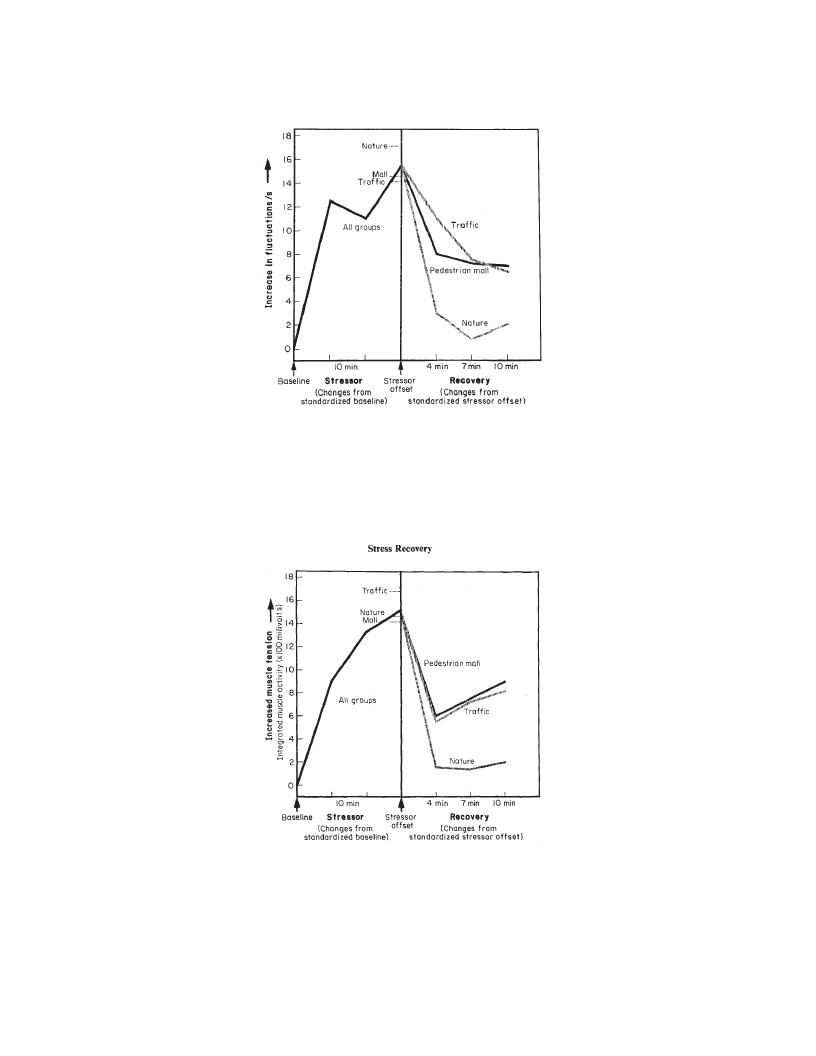
27
Figure 1. Alterations in Skin Conductance (SCR) in stress and recovery (Ulrich et al., 1991).
There is a temporary drop during the stress and also in the recovery phase when stress is turned
off. (Permission to reuse this figure was received from the author.)
Figure 2. Alterations in Pulse Transit Time (PTT) During Stress and Recovery (Ulrich et al.,
1991). The pedestrian mall and traffic views are seen to arouse rather to restore during the
recovery phase. (Permission to reuse this figure was received from the author.)
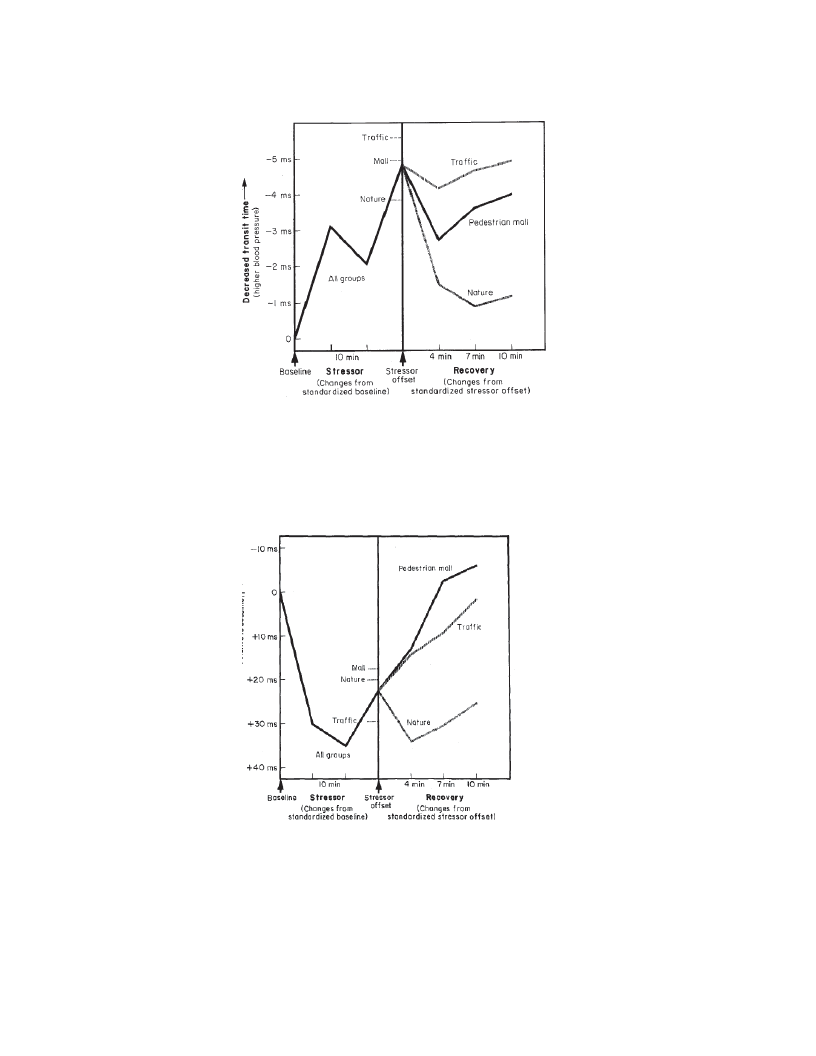
28
Figure 3. Alterations in muscle tension (EMG) during stress and recovery (Ulrich et al., 1991).
The pedestrian mall and traffic views are seen to arouse rather to restore during the recovery
phase. (Permission to reuse this figure was received from the author.)
Figure 4. Alterations in heart period during stress and recovery (Ulrich et al., 1991). This
measure is an indicator of intake/attention, unlike the other measures. (Permission to reuse this
figure was received from the author.)

29
Seventy-two undergraduate students were categorized into four similar groups that
ranged from all-natural views to all built views at a large Midwestern university, with most of
the students being juniors or seniors. Participants were administered tests once in their rooms
with neurocognitive and directed attention measures: the Digit Span Forward (DSFT) and
Backward (DSFT) and Symbol Digit Modalities (SDMT) (Lezak, 1983), the Necker Cube
Pattern Control Test (NCPC) (Cimprich, 1993), and a subjective rating using the Attentional
Function Index. Data that showed sample size of all-natural view with n = 10 should not be
considered because of the low sample size.
This study concluded that university students with views of natural settings may have
benefited from increased ability and capacity to direct attention. The only measures that showed
significant effects were the SDMT (All and Mostly Natural = 68.95; Mostly & All Built = 62.29)
and the NCPC (All & Mostly Natural = - 62.35%; Mostly & All Built = -35.87%). All others
had probability that was higher than 0.05. In addition, the sample size of 20 is low that grouped
All & Mostly Natural statistics. Nevertheless, SDMT measures directed attention when the
subject is performing complex tasks, and NCPC measures the ability to block out competing
stimuli. These measures are key in directed attention and when combined, validate the
hypothesis that for these university students, their natural views promoted greater directed
attention ability.
In 2012, Raanaas, Patil, and Hartig studied the effects of windows to natural settings on
patients in a rehabilitation center with similar, but not as comprehensive, results. In a quasi-
experimental study, they hypothesized that based on past studies such as by Ulrich et al. (1991)
and Tennessen & Cimprich (1995) a private room with a window view to a natural setting would

30
have healthy effects on rehabilitation patients and their general well-being. Three types of
window views were used in the study with blocked, medium, and high nature views. Patients
were tested at five different time points from arrival at the center to two weeks after returning
home, with 250 lung patients and 345 heart patients used 52 rooms. Outcome measures were
self-reports.
Clients with panorama views were most satisfied and in blocked-view rooms, least
satisfied. Patients with panoramic views used their room to withdraw for privacy possibly
alleviating the demands of the center and their difficult health issues. Findings supported
Ulrich’s view that passive contact with natural settings may help patients cope better with the
difficulties of illness. This study did differ from Ulrich’s study in that a blocked view did not
adversely affect the mental health of women as it did men during their stay, but women were
more positively impacted by a panoramic view than men. Also, no effect was shown on
emotional states or subjective well-being (Raanaas et al., 2012, p. 31). This could have been due
to a greater emphasis on health perceived in the preceding week. Lung patients had more
positive effects than heart patients. The researchers hypothesized that this could have been due
to greater restraints that patients must undergo in their treatment which would lend themselves to
greater appreciation of views due to their forced stationary situations. The recommendation
based on this study is that particularly vulnerable patients should be given the nicest views.
To find buffers for the toils and adversity in the lives of children, researchers in 2003
studied 337 children who lived in rural areas (Wells & Evans, 2003). Though many studies
found that adult time spent in natural environments is associated with better mental wellbeing,
researchers were beginning to substantiate these findings in children. Children’s preference for
running free in the outdoors could stem from an evolutionary bias and an affinity for places
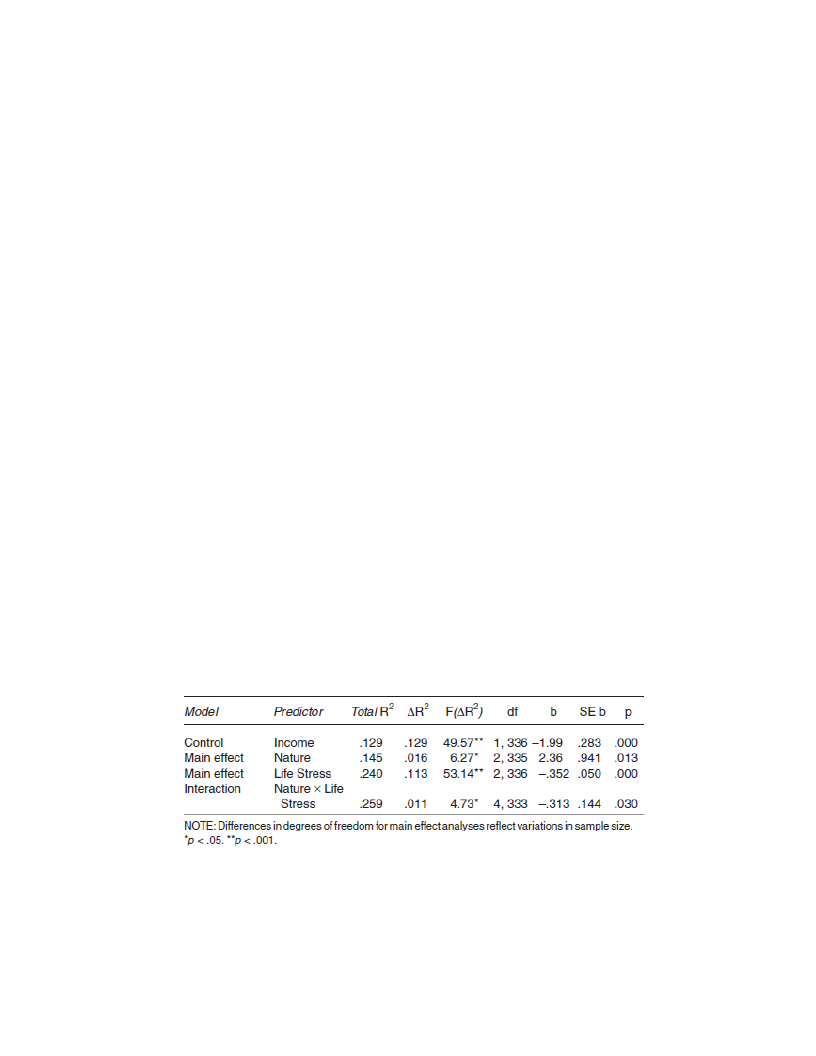
31
where they may not only enjoy but thrive. Nature as a hypothesized buffer could attenuate
adverse effects of stress or other large, negative effects that degrade good health or well-being.
Socio-economic levels of the children were controlled because it is another independent variable
due to its potential effect on children’s health and well-being. Their mean age was 9.2 years.
Findings showed in Table 1 that the effect of life stress and life stress with nature on
psychological stress was 53.14 to 4.73 F, respectively, which was a very large decrease in stress
levels as a result of association with natural surroundings. (Permission to reuse this table was
received from the author. See Appendix C) In Table 2, the effect of life stress and life stress
plus natural surroundings on the children’s global self-worth were also considerably positively
impacted: 40.54 to 10.64 F, respectively. Figure 5 indicates the effects of low to high nature on
psychological stress revealing that nature was particularly beneficial for highly stressful life
events (Wells & Evans, 2003).
Table 1.
Regression of Children’s Psychological Distress (Rutter) Onto Nature, Life Stress, and the
Interaction of Stress x Nature, Controlling for Income (Wells & Evans, 2003). (Permission to
reuse this table was received from the author.)
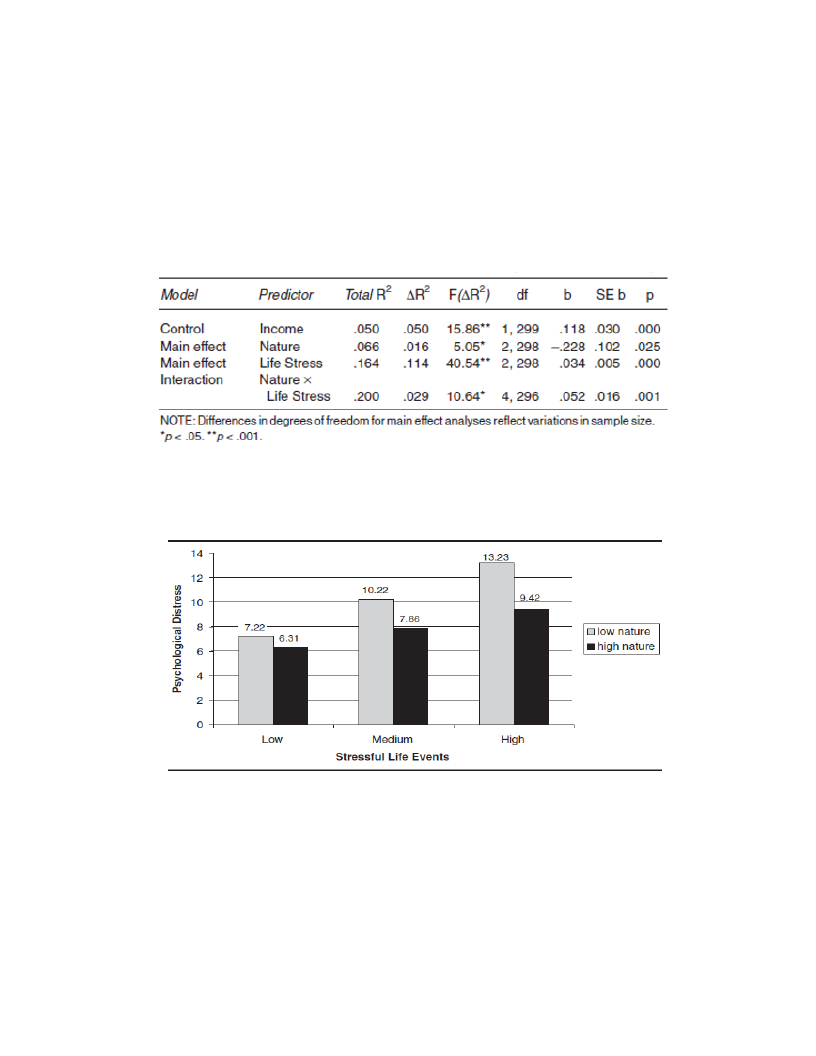
32
Table 2
Regression of Children’s Global Self-Worth Onto Nature, Stressful Life Events, and Interaction
of Stress x Nature, Controlling for Income of Family (Wells & Evans, 2003). (Permission to
reuse this table was received from the authors.)
Figure 5. Nature moderated effects of stressful life events on psychological distress.
(Permission to reuse this figure was received from the author.)

33
Karmanov & Hamel (2008) argued that urban environments could meet the same
standards that Kaplan & Kaplan (1989) identifies for the four restorative environmental qualities
of the feeling being away, fascination, sufficient extent, and compatible with human needs. In
this way, they hypothesized and attempted to show empirically that well-designed and attractive
urban environments may have a stress-ameliorating and mood regulating quality equal to a
nonthreatening natural setting. To do this, he compared Amstellan in The Netherlands with a
newly developed area of excellent architectural quality with front gardens, lots of water, and
canals of different shapes with various levels of traffic. He also added cultural information as an
independent variable to show the impact of knowledge, or narrative, on the experience of places.
He hypothesized that a well-designed urban area with its own narrative would have the same
effect as natural surroundings on mental states.
Participants in the study were 86 freshman and sophomore psychology students from the
University of Amsterdam (63.5% females and 36.5% males, with an average age of 21.5 (S.D. =
5.1). They were randomly assigned to four groups: two natural setting groups with or without
narratives, and urban settings with or without narratives. The number of participants in these
groups was 26, 21, 19, and 19, respectively. Researchers controlled for equal types of
participants in both groups, verifying that the natural environment selected was indeed
considered such, and ruled out any effect of the commentary on the videos that were shown to
depict natural and urban environments. Results are shown in Table 3. (Permission to reuse this
table was received from the author.) These researchers theorized that a combination of water,
green spaces, and design in the urban space selected lead to raising its positive mental effects as
high as a natural setting in most ways. The exception was that the urban setting did not restore
depression as well as the natural setting, based on the data shown in Table 3.
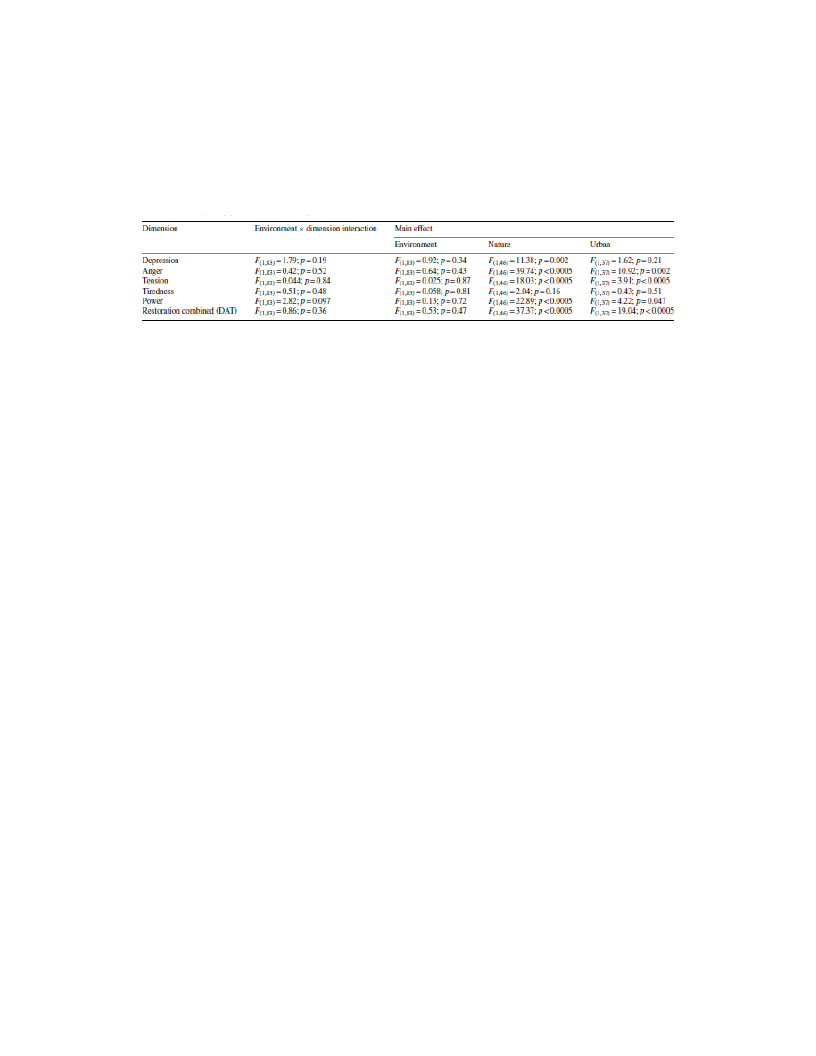
34
Table 3
The effects of natural and urban environments on dimensions of affective restoration (Karmanov
& Hamel, 2008). (Permission to reuse this table was received from the authors.)
Discussion
The findings of Ulrich (1991); Tennessen & Cikmprich (1995); Raanaas et al., (2012);
Wells & Evans (2003), and Karmanov & Hamel (2008) show the potential improved cognitive
effects of incorporating natural settings to promote recovery from physical and mental distress.
Wells & Evans demonstrated that natural surroundings or nature close by can counter the effects
of stressful events in the case of children. Would it be advantageous for adults who are in
distress to be exposed to outside natural settings versus exposure to inside natural surroundings,
such as having indoor houseplants? Could mental health professionals and psychotherapists use
outside, nonthreatening exposure to natural settings as an additional tool in the treatment of
chronically distressed mental health patients? Based on these studies on the psychological
effects of nature, it would be prudent to hypothesize that exposing low-income single mothers to
indoor or outdoor nonthreatening natural settings would aide them in their recovery by
strengthening their directed attention abilities and lowering their stress.

35
Method
A qualitative study was performed to deepen general understanding of the possible lived
experience of low-income single mothers, and to analyze the validity of a nature-based, self-care
mental health intervention for further study. This qualitative, ethnographical study explored the
lived experience of nine low-income single mother participants (n = 9) and the ways in which
their intentional exposure to natural settings may be mentally and/or physically beneficial to
them. Appendix A lists the semi-structured participant protocol that was used by myself to
conduct one-hour interviews with volunteer participants.
Data were collected through interviewing the participants in one-on-one, one-hour-long
sessions and with a protocol of questions that were open-ended to prompt the participants to
share descriptions of broad aspects life. The identity of research participants was confidential
and will remain so. All regulations and guidelines related to the protection of potentially
vulnerable research participants were followed.
Interview Process and Protocol
The interview protocol (Appendix A) was developed to provide a forum in which the
informant could freely divulge states of being, actions, and events in their lives without bias
being transferred to the participant either by the questions or the interviewer. The protocol was
intended to allow the participants to freely give their own description of their experiences while
allowing the researcher to discover the meaning of actions and events in their lives (Spradley,
1979). The first and last questions in the protocol were what is known as grand tour questions in
that they were general questions to collect descriptions of the central topic of our research
question: i.e., low-income single mothers and any efficacy information in using ecotherapy. The

36
last question attempted to inquire about any topic of interest that they may want to share about
themselves that may have been missed.
Other questions in the protocol were attempts to discover whether, to what extent, and in
what ways the description of the lives of single mothers in the literature review were culture-
bound (see Spradley, 1979). Did these studies in the literature review represent the current lived
experiences of single mothers? For example, were they viewing single mothers as deprived
based on a normalized view of parenting as being a two-parent undertaking?
General commonsense topics were asked that generated self-reported descriptions of their
lives, such as their relationship with the father, employment status, health insurance, mental
health services, housing, finances, extended family, legal system, culture and ethnicity effects,
and stressors. Questions about the participant’s exposure and relationship to nature were also
present. Other questions measured informally addressed their possible stress level and other
mental health cues to analyze the possible effect of nature on the stress level and other qualities
of the lives of the study participants.
Recruitment Criteria and Data Collection
The criteria for selection of participants were that she identified as a woman of any age
who had birthed or had legal custody of a child of any age, who was legally single, not pregnant,
and whose yearly income was low income and/or below the poverty line. When a prospective
recruit asked if she could participate even though her son was over 18 and no longer living with
her, she was included after consulting with my Antioch research advisor overseeing this project.
Since the birth of her son, she had remained a single mother and had often been in and was
currently having financial hardship. When one participant asked if she could be included even
though she made approximately $25,000 which is over the $16,460 poverty line with one child, it

37
was decided that this amount was indeed still very low to take care of herself and her four-year-
old son in Flagstaff, which she confirmed in the interview.
Other criteria were that they enjoyed and regularly sought out spending time in or around
nature of some sort and were asked several questions about it (see Appendix A). As a research
preference, it was assumed that an in-person interview would be far more informative than phone
interviews, and this was the preference during recruitment. No one who contacted me about
volunteering as a research participant was turned down because all interviewed women stated
that they had children, were in poverty, and that they were not living with, or did not currently
have a romantic partner.
Because research in this population indicated that it was likely that these women may be
under distress or stressed, I initially spoke with eight out of the nine participants on the phone
briefly (and in one case, we texted), to make sure they were members of the population that I was
studying, to schedule a one-on-one interview at a place where they would like to meet, and to
ensure (as much as a short conversation over the phone could suffice) that they would likely be
emotionally strong enough to discuss a possibly difficult personal history, if they decided to do
so, without possibly triggering distressing emotional deregulation. During my initial
conversations with participants, I also tried to build rapport by telling prospective participants a
little about myself, where I was in my doctoral program, where I was from, and so forth, so that
the subsequent interview conversation could go smoothly and comfortably for the participant. I
also asked each participant if they had a place where they would like to meet and interview.
Preferences that the participants suggested for meeting places appeared reflective of these
women’s circumstances: MacDonald’s, a park, a retail place of work, and their favorite coffee

38
shop. I was also able to reserve space at the central Flagstaff Public Library and a community
room at a natural food store as well.
Not including pregnant women as participants was due to the added precautions and
resources that must be taken and utilized to include a potentially medically and emotionally
vulnerable pregnant women as a subject in a research study and the limited resources of this
project. Regarding a participant cohabiting with an intimate partner, she could not have been
included in this study because of the psychosocial and economic differences of this situation
compared to single mothers living alone with their children, and possibly other persons. No
prospective participants who contacted the researcher about being included in this project
reported that they were pregnant or were living with romantic partners.
Advertisements for participants were posted in the states of Arizona and California. To
recruit participants, a flyer was created and approved by the Antioch Institutional Research
Board (IRB) during the IRB approval process to advertise for participants. A Spanish translation
of the flyer was also created in hopes to recruit Spanish-speaking participants, or other diverse
low-income mothers. A Spanish interpreter whose mother was a low-income single mother
volunteered to help interview participants. Unfortunately, no Spanish-speaking prospective
participants contacted me to be included in this project.
At least 60 fliers were put up on community bulletin boards in grocery stores, coffee
shops, restaurants, libraries, domestic violence shelters, medical health clinics, and laundry mats,
in the towns of Flagstaff, Oak Creek, and Sedona, Arizona in places where low income mothers
could have seen them. A brief Craigslist advertisement was also created under the community
volunteering section in the cities of Flagstaff, Phoenix, Tucson, Los Angeles, and San Francisco.

39
Recruitment of research participants took place from November 2018 to February 2019.
Three participants were interviewed on the phone; the rest, in person. The identity of the
interviewees were kept confidential. All recruited participants were living in the state of
Arizona, and eight out of nine participants were recruited from the rural areas of Flagstaff,
Sedona, and Overgaard, Arizona. One participant responded to Craig’s List advertisements and
lived in Tucson, Arizona. Six of the nine participants lived in Flagstaff, Arizona, which is a
small mountain town. The ages of the participants were from 28 to 58, and the average age of
the participants was 39. The actual ages were 28, 30, 31, 35, 37, 38, 43, 51, and 58, which is
also the order in which they were interviewed.
Participants were compensated for their participation with $10 and a list of general
health, housing, safety, and educational resources created in MS Word for the city in which the
participants lived. Three community resource lists were created for the cities Flagstaff, Sedona,
and Tucson, Arizona, where eight out of the nine participants lived. One participant who said she
was glad that she could take part in the study lived in Overgaard, Arizona and said that she did
not want the customized list of resources nor the $10 compensation that the project offered for
participating.
Case Selection and Analyses Methodology
Selection of participants utilized the following qualitative research methodologies:
influential, collective, and cross-case. The case selection reflected an “influential” strategy in
that “sometimes, the choice of a case is motivated solely by the need to check the assumptions
behind some general model of causal relations” (Seawright & Garring, 2008, p. 303). The larger
cross-case theoretical model being examined in this study was the possible mental health benefits
of experiencing nature for this population. In this study, also nine participants “collectively” met

40
general targeted socioeconomic criteria: low income, not living with a partner, and single.
Another important and necessary selection criterion was that they reported that they regularly or
in general in their life enjoy natural settings or elements either indoors or outdoors and found
them to be therapeutic mentally. Lastly, cross-case analyses performed as part of this study
gathered collective case knowledge and compared and contrasted this knowledge to produce new
knowledge (Kahn & VanWynsberghe, 2008).
Another methodology used was ethnographical interviews and analyses tools. Spradley
(1979) stated that a great deal of applying and using ethnography interviewing is to be able to
“learn, hear, speak, think, and act in ways that are different. Rather than studying people,
ethnography means to learn from people” (Spradley, 1979, p. 3). Therefore, the interviewer’s
prewritten questions were loosely followed to develop a natural conversation between two
equals. To every participant, I said “you’re welcome to ask me questions about myself and my
life if you want, but what I’m here to do is to hear your story.”
The interview protocol (Appendix A) was developed to provide a forum in which the
informant could freely and naturally divulge states of being, actions, and events in their lives
without the interviewer interfering in some way with this process (e.g., being overly opinionated
or acting scientific, self-righteous, or authoritative) which developed a friendly rapport with the
participants. The protocol was intended to allow the participants to freely give their own
description of their experiences while allowing the researcher to discover the meaning of actions
and events in their lives (Spradley, 1979).
In this analysis, the ‘theoretical sampling’ that I performed by seeking to interview and
analyze only low-income single mothers who enjoy nature was coupled with an analysis that
does not range far from the actual words of the participants in the quest to hear their words and

41
find their meaning. This method was similar to Flick’s (2014) description of a closeness to the
data in qualitative work that allows the researcher to let the data guide the research. In this way,
researchers do not navigate through the data every which way looking for excerpts for filling
categories, but apply the principle of sequentiality…This means the material is analyzed from
beginning to end and following its temporal development” (Flick, 2014; Wernet, 2014, and
Toerien, 2016).
During the interviews, I used an I-Phone application called “Recorder” to audio record
the interviews and then I transcribed them into Microsoft Word 2016. I grouped the transcribed
data by protocol question and by coding the text by themes that were present other than the
protocol question topics. The participant interviews were summarized, and general themes and
findings were reported. Similarities and differences between the literature review and the
interview data were summarized. Results, conclusions, newly discovered questions and
hypothesizes, if applicable, were described. As the sole researcher in this qualitative research
project, I also throughout this text I added sections that described my thoughts, feelings, and
reactions to the participant narratives. In this way, I identified my own subjective experience as
a researcher, as well as the subjective experiences of my research subjects, to identify any biases
I may have as a researcher and to add greater meaning to this work.
Furthermore, an attempt was made to explain conclusions theoretically using existing
theoretical and philosophical frameworks to add context and perspective to the conclusions of
the study. Limitations of the study were also be included. Social, psychological, economic, and
theoretical implications of the findings will be explored in the context of the ways that these
research results may influence psychological treatment of these mothers by government planning

42
boards, social services, and others who are actively looking for ways to improve the lives of
these families and lower overall poverty and mental illness in the United States.

43
Results
The research questions of this study were the following: (1) What are the current lived
experiences of low-income single mothers in the United States; (2) What interventions or
resources have been found to be helpful?; and (3) Does exposure to indoor or outdoor natural
settings improve the mental health of low-income single mothers?
In this results section, I structured this narrative of my research results in the following
way: first, I summarized the responses of the participants to each protocol question if they
responded. Then I discussed other topics brought up by participants answering this question that
had “popped” up in conversation and appeared to me to need “unpacking,” or appeared fraught
with meaning where further discussion or analyses seemed warranted.
In all the interviews, the participants reported prominent themes. I identified these
themes by the frequency in which it was brought up by participants, the vehemence of how it
was spoken, its apparent truthfulness, and/or that the topic resonated as an important possible
aspect of these women’s lives. These themes or topics could serve as talismans for further study
of key known or unknown influencers in this population’s lives.
Question 1: What can you tell me about your life in general as a single woman with a child
(or children) living on a small income?
Answers to the first grand tour question from the interview protocol (Appendix A) about
how the participants were doing in general appeared to reveal how they were feeling about their
life in the moment, and current events in their lives. Topics included excessive busyness in that
“every chunk of time…accounted for in some way;” life as a musical performer--“I’m just an
open book basically…I don’t mind talking;” and recent preschool grants that were greatly
changing the lives of one mother and her child mostly for the better.

44
Another mother responded to the grand tour first question by talking about her life being
homeless with a daughter in the forest--“I’ve been living on the road on and off my whole life.”
One mother spoke of the time raising her son alone as filled with severe social discrimination
against her as a single mother; another described the pain of poverty and not being able to finish
college education or the difficulty of finishing in their status. One mother felt she was destined
to have her two children because of her two unintentional pregnancies, though she and her
partner had used birth control. Another mother described her stress from the strain of poverty in
a relatively expensive university mountain town. One woman did not answer this question.
Summary and interpretation of findings. Overall, these women felt burdened by their
status as low-income single mothers in the following ways:
x The overall stressful and burdensome “costs” of being the single supporting
parent of four children were burdensome in terms of lack of personal time and
rest.
x Overall, as a musician, songwriter, and part-time waitress, low-income single
motherhood was “financially challenging and mentally de-stabilizing.”
x Positive change had recently occurred with one mother despite poverty and lack
of time when public services assisted with educational and childcare expenses.
x A mother described the historical fact of her lifelong homelessness and now
literally made her home in nature with a small child under five alone in camper in
parks and forests.
x Emotional pain possibly caused by self-described isolation, shame, and social
oppression was due in one mother’s view to overt gender and class discrimination
and prejudice.

45
x One mother described the general mental and physical pain of poverty, such as
loss of educational and vocational opportunities, and the problem of
discrimination and stigma against single parents, and especially single mothers.
x Another mother described the general pain of poverty that she experienced
through no fault of her own having used birth control and still having had two
unintentional pregnancies, and now living in a small relatively expensive rural
resort area with fewer opportunities to advance her education and income than in
other areas.
Description of the Qualitative Research Modalities that Were Used
One mother responded to question one that she couldn’t speak about other’s experiences
or make generalities about low income single mother life—that “it’s different for a lot of
people…but I guess…in the things that were helpful… knowing as early on as possible the
importance of positive thinking and that our story is only what we say it is, and time determines
what that story is.” This statement resonated with me as an articulation of a problem with
attempting to study and come up with a “general” description of this population or even other
groups of people, big or small, along with the fact of the uniqueness of all people.
This research attempts to solve this humanistic research quandary by using a hermeneutic
and phenomenological approach (Laverty, 2003) to analyze these narratives. As this mother
pointed out, a woman telling her story is “meaning-making,” and in hermeneutics, meaning-
making and time produces “narrative,” which is also called “story” or “text (Glick, 2016).”
Using a hermeneutic and phenomenological approach, truthful understanding of lived
experiences can be achieved by analyzing the research subject’s narrative of her lived experience
and narratives of both the researcher and the research subjects’ social, political, and historical

46
contexts. “Meaning is found as we are constructed by the world while at the same time, we are
constructing this world from our own background and experiences” (Laverty, 2003). In other
words, our environment affects us, as well as our background and experiences. My research
modality acknowledges a subjective, socially constructed world where truth and understanding
of human experience is found in research in exposition of the experiences, environments, and
biases of both researcher and subject (Flick, 2016; Werner, 2016; Torien, 2016; Laverty, 2003).
This mother’s comment about the fruitfulness of “having a positive attitude” showed this
participant’s possible bias in her describing her experience positively while still being truthful. I
make this point in the context of Werner’s (2016) description of hermeneutical examination of
“the differences, tensions, and even contradictions between intentions and the latent meaning of
action” (Werner, 2016, p. 236).
Another mother had this to say about the benefits of having a positive attitude:
…living off student loans, racking up student loans [and living on public assistance], I
eventually lost my home. We had that whole trial. It was an interesting experience for
my son to really realize that material things weren’t as important as having each other
and just getting through some hardships. I’m back to finding the little jobs. I’m trying to
do things that bring me more joy cause even though I had a lot of experience in the
banking industry, it wasn’t a passion of mine.
It is important to note that each of these women discussed positive thinking as part of their own
efforts to manage their mental health. A theme of material things not being as important as their
mother-child relationships and being able to surmount hardships was also present with several
of these mothers. Both of these mothers in the course of becoming and being low-income single
mothers were diagnosed with depression and anxiety (see the “Survival Strategies”) section.
This positive thinking effort and more humanistic and less materialistic perspective were likely

47
parts of their own self-help intervention or possibly recommended as a positive psychology
intervention by mental health providers.
When asked about the amount of stress she was feeling, the woman who lost her home
responded with level “15” out of 1 to 10 and that she at one time suffered from post-partum
depression. Another point about these woman’s stated strategy of having and cultivating a
positive attitude is that throughout all these interviews, these women often spoke of survival
strategies such as this that they used to help them cope with their situations. Identifying their
survival strategies about what worked for them to persevere in their difficult situation was a
pervasive theme throughout the interviews. It speaks to a kind of pragmatism that each woman
appeared to have: to keep problem-solving continually, and to keep an eye on their mental as
well as physical health and perspective when faced with their basic needs issues of food,
housing, and work insecurity, as well as their huge responsibility to raise healthy children
primarily on their own.
The theme of discrimination against single women and against low-income single
mothers was brought up by two women in the very first open question of the interviews. This
theme is prominent in the literature review discussed previously, and its prevalence as a topic in
these interviews may indicate discrimination’s continued damaging pervasiveness among women
in this population, as well as in the U.S. in general, since U.S. census studies continue to confirm
that these research participants and other women and families at their economic level and social
circumstances across the country are some of the poorest people and families in the U.S. (see
“Introduction,” and “Literature Review”).
One mother had this to say in response to Question 1:
It’s hard. ‘Been at this as a single parent about 25 years. I’ve been at this awhile, and
honestly, I’m no better off today than I was 25 years ago. In spite of even educating

48
myself (I do have a Bachelor’s degree in Human Services), so even in spite of doing what
I’m supposed to do to make our life better regardless of where we’ve lived or what I’ve
done, I am no better off today as I was 25 years ago. I’m still on assistance. No matter
what I try or what I do. [I have] two children, ages 25 and 15. One is still in the home.
Just the 15-year-old is still in Flagstaff. It’s just disappointing. It’s frustrating and
disappointing. It says something about society, I believe.
Later in this interview in response to Question 8 and my follow-up question about the way in
which her employment may have been affected by being a single mother, she said,
Work hard, and you’ll make it. That’s not true in the American system anymore.
Women in particular. We’re still paid less than men. We still don’t have an equal rights
amendment. We’re already behind the starting line big time…I’ve never tried to make
my being a single a crutch of mine, and if you say single parent, other people frown, but
it’s easier to say single parent because there’s less of a stigma than saying single mother.
Another mother had this to say when asked Question 1:
What was harder than the low income was the social reaction to a single mother. As far
as a job, now they’re not supposed to ask if you have children, or if not, if you’re in your
child-bearing years, but I’ve been asked all those things…But often times they won’t hire
a mother, especially a single mother with little children because they’re afraid of the sick
days…
On this same topic, she included this statement in her response to Question 2: “you can’t be more
villainized than being a single mother,” she said. “People don’t help single women. It’s almost
like we’re a contagion. We’re an embarrassment.”
Thoughts and Feelings of the Researcher and Overall Possible Researcher Biases
I was deeply touched by both of the last two women’s remarks when I interviewed them,
as well as when I reviewed the text of their interviews. It brought up feelings of distress that I
have about my own lack of property ownership and “normal” financial success and the fear that
discrimination and “the glass ceiling” has had something to do with it over the years. I have two
Masters’ degrees—one in English/Creative Writing and the other in Clinical Psychology from
University of New Mexico and Antioch University, Santa Barbara, respectively. I’m a 58-year-
old doctoral student who is female and has felt discrimination because I am a woman in business,

49
work, and social circles. I am also a biracial White and Latina heterosexual women in this
society. I have not experienced racism that I know of possibly because I was raised in White
culture, my Latina race was hidden and not discussed in my family, and I appear to be White.
My poverty as a student is possibly understandable logically, but I can empathize with these
women having been a poor student now for six years. As a human being, I also cannot help but
have compassion for these women I came to know as part of this study whose disappointment
about lack of financial success and reported discrimination I felt in my life as well.
Prior to deciding to acquire my doctoral degree in Clinical Psychology (PsyD), I worked
as a technical writer, business analyst, and project manager in high technology, and worked for
three Fortune 500 companies in Southern California, and two federal agencies as a contractor.
At this same time, I am a published poet. In my twenties, I was married at 25 and divorced at 30,
and married and divorced again in my 40s—both time for irreconcilable differences and abuse
issues. I have been single a total of 15 years out of my adult life, and I have seen and felt the
discrimination against single women often, such as when I have applied for home mortgage
loans, being or not being seated in restaurants, employment disadvantages and refusals to hire
single women, and being excluded in social occasions with groups of couples. There have been
incidents of aggression toward me being the only woman at the table. Now that I am middle-
aged, finding work has become much harder. I feel an added ageism, as well as a general sexism
that looks and feels sometimes like a cloud of patriarchy hovering over everything.
I already had a depth of experience before I began this feminist project in terms of the
trials and tribulations of single women. Not having children was not so much a decision, but the
failure to find a male partner with whom to have children and the knowledge that it would be too

50
difficult for me financially and emotionally to have a child on my own, despite having a life-long
dream of raising children.
I believe in equality for all and have volunteered for equality and social justice initiatives
throughout my life. Regarding my choice of this topic, people may wonder why I would have
chosen this topic not being a mother myself. In my friendships during my 20s-40s, I had been in
some cases the helpful friend to single mothers that were friends of mine and were struggling. I
couldn’t believe their struggles having to choose between wanting a good job and career and the
large amounts of time, talent, and resources it took to achieve this, and trying to be the best
mother you could be. It seemed so hard to do both without a second parent—so this was a
choice I decided to avoid.
There was also the incident that happened in my distant family when I was 19. One of
my close female relatives was a young mother with three young children all under the age of five
years old in Los Angeles when her husband put a gun to her head during one of their fights. She
divorced him, but the legal battles and her financial struggles seemed so difficult. Another
female relative “rescued” her, and made sure she was able to find housing, assistance, and work.
I do not think she and her three kids would have made it otherwise. I also saw what the stress
and distress on her and her kids became: for example, one child became developmentally
challenged, and she still supports him as a disabled adult. She did rise professionally, and
despite a four-hour work commute every day, she has financial security, and her other children
have become relatively successful adults.
To sum up my biases, I am a feminist and a biracial heterosexual woman, and I did bring
to the study of this population a strong sense that these women I planned to study were often
overtaxed, and that women in general, single women, and especially low-income women of color

51
were often targets of sexism and racism. However, I have tried throughout this project to bracket
my views, and to genuinely be open to just what the existing research and interviews revealed
about the lived experience of these participants. If they wanted to know my bias, I felt I had a
duty to tell them, though I did not volunteer the information nor steer their views in any
direction.
Question 2: Where are you from originally? What town do you currently live in?
Table 4 shows the places where participants said they currently reside, and whether they
have been married. I did not reveal their places of origin and in some cases in the text, the town
they lived in to protect the privacy of these women. Making some separate tables for different
topics/data was also an effort to preserve privacy.
Table 4
City Where Participants Lived and Whether They Are Happy Living in Their Town in Their
Situation as a Low-Income Single Mother
Residence
Current Type of Housing
Flagstaff, Arizona
Flagstaff, Arizona
Flagstaff, Arizona
Sedona, Arizona
Overgaard, Arizona
Flagstaff, Arizona
Flagstaff, Arizona
Tucson, Arizona
Flagstaff, Arizona
Section 8 renter
Owns her home
Public Housing
Homeless in Camper
Renting
Renting
Section 8 renter
Staying with her ex-
husband
Staying with her
employers
Happy Living
in Their Town?
Yes
No
Yes
Yes
No
Yes
No
Yes
Yes
Several participants commented on the theme of small-town living. One mother who is the sole
financial provider for her family appreciated her small town because the business license that she
was able to buy to start her housecleaning business was only $25 at the time. In their small rural

52
town, they were able to find a nice campground when they first came to town after her violent,
physically abusive husband of 17 years abandoned her and her four children approximately eight
years ago: “…we had a nice facility there [at the campground], good showers, and they had a
nice laundry room. The kids have excellent memories of making our valentines at big tables.”
Since her bitter expensive divorce, her ex-husband returned to the town where they live and has
now been homeless for two years and swore that she “would not get blood from a stone.”
Yet another mother complained that it was a big mistake to think that getting out of the
big city of Phoenix and moving to “Mayberry” would help her keep her son out of trouble and in
school. She said the area she moved to turned out to be poverty stricken which made it difficult
to leave: “[Childhood] drug use was really scary when I moved here, and there was all that kind
of stuff. I was lucky because most of the kids here end up involved in that stuff. If people ask
you if you should move to a small town and whether it would be better for us, say no!”
Another mother had difficulty in her small town getting quality health care for her child
because “…I haven’t been able to keep a doctor. All of my doctors keep leaving.” Also, of all
the places she has lived, she felt her small town was the worst socially and financially, but she
felt no point in moving.
One single mother had this to say about her small town and her poverty: “It’s definitely
hard to make it here. The locals call it ‘poverty with a view’, and it’s kind of true.
Unfortunately, even if you’re doing okay. I make almost $18 an hour so I get paid pretty well. I
just work 30 hours a week.”
In summary, six out of nine women felt good about where they lived, but the other three
women felt disadvantaged by their small rural town. Habarth, Graham-Bermann, & Bermann
(2009, p. 229) found that “low-income women’s coping is linked to the availability of resources

53
in their communities.” Several of the participants were on public assistance for housing, food
stamps, Arizona AHCCCS, which provides full free health care with affordable deductibles for
themselves and their children. Most of these women also appeared to have sought out any other
types of public assistance they could find: “I have a lot of resources around me and try to take
advantage of that as best as I can,” one mother said.
Selecting a town or city to live in that provides enough social services for single mothers
could be a crucial step for these women. Overall however, as one of the mothers found out,
preconceptions about the suitability of a place could be found to be mistaken after a family
relocates, and then lack of mobility due to poverty could make it seem impossible to move to a
better environment for themselves.
Question 3: How much education have you received (degrees, training?)
Table 5 summarizes data concerning the age, marriage, children, education, and health of the
participants.
Table 5
Statistics of Mother’s Age, Children, Education, and Health Issues in Participant Families
Participant
1
Mother’s
Age
43
Ever
Married?
Once for
17 years
2
30 Once
3
31 No
Children
Four
children
ages 12, 13,
15, 17
One son,
age 4
One child,
age 6
Education
Community
college,
private
classes
Bachelor of
Arts in
Theater and
Photography
High school
graduate,
college
classes
Reported Family
Health Issues
One younger child-
autism and type 1
diabetes. Mother
has an auto-immune
disorder.
Mother has
depression and had
post-partum mania,
and has seen several
therapists
Mother has PTSD
from childhood
trauma and Bipolar
2, has attempted

54
Participant Mother’s Ever
Age Married?
4
28 No
5
58 No
6
35 No
7
51 Once
8
38 Twice
9
37 No
Children
One child,
age 2
One son in
his early 20s
Two
children
ages 10 and
11
Two
children
ages 15 and
25
Three
children
ages 10, 12,
and 20
One child
age 10
Education
Some high
school
High school
graduate
Associate’s
degree in
General
Studies
Bachelor’s
degree in
Human
Services
Associate’s
degree in
Occupation
Science with
an emphasis
in Raspatory
Science sand
extra credits
Associate’s
degrees in
General
Studies and
Sign
Language
Reported Family
Health Issues
suicide twice, is
currently stable with
family, therapy, and
prior in-patient
support. Polycystic
Ovary Syndrome
(PCOS)
All healthy
Son suffered an
assault growing up,
but is healthy;
mother has several
challenging physical
ailments
Mother has vertigo
Younger son has a
traumatic brain
injury and chronic
pain from a car
accident
Mother diagnosed
with depression and
anxiety with
memory problems,
but has improved
Mother has
Temporomandibular
Joint Dysfunction
(TMJ), depression,
and anxiety; high
stress level—15 out
of 1-10
One of the mothers who said she struggled with mental illness and her “15” stress level out of
1-10 and who also used positive thinking to help her had this to say about her education:

55
Nowadays, if you don’t have a college degree, a high school diploma doesn’t get you
very far…I had been in the banking industry pretty much since high school. It was a
great job up from teller to assistant manager but I still hit that glass ceiling where I didn’t
have a bachelor’s degree so I couldn’t go up the ladder. So anyways, I was working for a
bank in Sedona, and it was shut down by the feds [during the recent great recession], and
a bunch of us got laid off. Here I was, my son was about two years old at the time with
no job. That was kind of a freak out. I just instantly buckled down and got on AXCCCS,
food stamps, and made sure that I qualified, I made a little money from losing my job.
Anyways, while I was trying to figure it all out, I decided to go back to school. I went to
the community college here in Flagstaff, Coconino College, and got a general Associate’s
degree as well as an associate’s degree in sign language. But, you know, that whole
process was interesting too because here I was with a toddler going to school part-time
working five part-time jobs and trying to manage it all. So it was an interesting
experience. I realized I could do a lot more than I thought. So I was able to get all that
done. So anyways, [my job in banking] wasn’t a passion of mine. It was just something
that I kind of fell into.
In her case, her disinterest in attending college earlier in life became restrictive when she realized
that she needed a degree to be promoted at work and was also more vulnerable in times of
economic crisis.
Another mother who had a diagnosis of PTSD, other mental challenges, and a physical
medical issue said about acquiring her education: “[I have] [s]ome college. I tried college three
times, and every single time it was too overwhelming for me.” One mother said she had a
“domestic” education. She was divorced, was abandoned with her four kids, and was the victim
of domestic violence: “…My education was, you know, mostly I spent 10 years as a stay at
home mom [before her divorce], a domestic education, mostly community college, theater and
aviation...”
One woman said she did not like the small rural town she lived in and regretted her BA
degree major in photography and theater. (This appeared to me to be due to her inability to find
a good paying job in her small rural town.) Another mother did not receive much education
because she and her sister were raised by her homeless mother in the forest, where she continues
to live with her 2-yr-old daughter. In first grade, her teacher would come and pick her up from

56
their camp since her mother did not have a car. “Then we just started traveling again because it
was the only way to survive or for my mom to survive. She was just selling her art and crafts.”
The woman who said single women are treated like a “contagion” said that she wished
she had had more schooling. She was a high school graduate but also was extensively self-
educated and had worked as a clinical exercise specialist, childbirth educator and labor attendant,
and aerobic training. “I always wanted more education … Maybe if you have a spouse, or more
support, you can go to school and work and be a mother, but a single mother, it’s impossible
because you can’t go to school, go to work, and be a mother.” Another mother with two
elementary school aged children had an Associate’s degree and plans on going back to school in
the fall to become a pregnancy consultant.
But perhaps it is a misnomer to presume that low-income single mothers cannot achieve
degrees that they want, or if they could, they would be better off. Another mother complained
that
“I do have a Bachelor’s degree in Human Services, so even in spite of doing what I’m
supposed to do to make our life better regardless of where we’ve lived or what I’ve done,
I am no better off today as I was 25 years ago. I’m still on assistance. No matter what I
try or what I do.”
This research showed that the varying levels of success that these women had acquiring
education to better the lives of their families did not appear at the time of this research to
guarantee that they and their families would be lifted out of poverty. In some cases, it appeared
that it may have helped them acquire work that they liked. One of these mothers with a
Bachelor’s degree said that she could not have a full-time job and raise her son, so she rented out
a room in her home using Airbnb and worked part-time in an art gallery. She was pursuing a
writing career that she clearly loved. Working in the gallery part-time allowed her to work on

57
her writing when there weren’t customers. She complained that the pay was close to minimum
wage without commission. She also was one of the mothers who was not happy in her town.
Reviewing Table 5 and the mothers’ comments about their education, it appears
that a post-secondary and in one case even a secondary education is an insurmountable challenge
for some of these women economically, mentally, or timewise. At one end of the spectrum, the
young homeless mother who said she had “little education” appeared to live semi-comfortably
and hygienically in her camper with her toddler.
Others were successful at chipping away at their undergraduate application a little at a
time first acquiring an Associate’s degree at community college level. Two women had earned
their Bachelor’s degrees, but both women said that their degrees did not help them out of their
financial slump.
Recent findings by Gault, Milli, and Cruse (2018) found that “just 13 percent of single
mothers with a bachelor’s degree live in poverty compared with 62 percent of single mothers
with less than a high school diploma.” The two women with their bachelor’s degrees were part of
the 38% of women with degrees who are in poverty. The participant who had “some education”
were part of most of this population who remain at this low economic level without completing
their basic education.
One possibility may be involved in the difficulty that these women with undergraduate
degrees had rising above poverty: They live in Flagstaff, which is a university town. Therefore,
there may be greater economic pressure with a larger amount of college graduates competing
within a limited economic base for jobs. With a Flagstaff population of about 70,000, about
30,000 of the population of this town is related in some way to Northern Arizona University.
The other 51-year-old mother with a Bachelor’s degree had been living in poverty for 25
years saw her poverty as endemic to the values of people in the U.S.: “I think we should look at

58
some other countries like Sweden or Norway or Denmark, and see how they take care of their
single mothers and what they do because their society is set up a little different and a little more
caring…”
Question 4: How many children do you have? What age are they? Do you and your family
have any health issues that you feel comfortable sharing with me about?
Table 5 lists children data and family health issues. The most surprising point in this
table was that the only family that reported that they were completely healthy among the nine
participants was the woman living alone with her toddler in a camper in the forest, who also did
not finish high school. She said that she works only three hours a day housecleaning where she
can take her daughter. The rest of the time, she spends mostly outdoors in rural national forest
areas. Comparing this mother to the two mothers with undergraduate degrees, one teenage child
had a TBI and required the mother to stay with him while she searched for a neurologist and pain
doctor. The other mother had been helped recently indirectly when her mother died, and she
inherited her family’s house in town. She worked three jobs and said she occasionally suffered
from depression as well as financial distress. The homeless mother did live in a different town
with a warmer climate about one hour away from the other two mothers, who lived in Flagstaff,
a mountain town that is cold in the winter. As described in the literature review, studies show
that access to nature may have a profound positive effect on mental and physical health.
Question 5: If you feel comfortable sharing, have you ever been married? How many
times?
Table 5 shows that four women had never married, four women had married once, and
one had been married twice. There were few, if any, descriptions of marriages; mainly
divorces—some grueling, some civil, and some women did not want to discuss the topic.

59
x The mother whose mother had recently died with a Bachelor’s degree and who was a
writer worked at an art gallery, worked at her local newspaper, and ran an Airbnb. She
was married once and said, “He wanted to party and go to strip clubs, and I’m like at
home buying furniture.” She was married at 20 and went overseas with her husband
when he was in the military. She described parties with other couples with excessive
alcohol, not fitting in, and she and her husband being two very different people being a
huge part of their parting after three years. He was not the father of her child, and
jokingly referred to her son as a “divorce baby” because she became pregnant while she
was dating shortly after her divorce.
x One woman who had been married for 17 years with four children was the victim of
domestic violence. “I had no control over anything…it felt like the director walked off
the set [when her husband abandoned her and her children].” She described her marriage
as having ended five years before she filed, and then the divorce took another five years
because her ex-husband fought it. The cost of her divorce was approximately $14,000.
x The mother who had a BA in Human Services and had two children was married once 16
years ago: He was an “absent parent.” “There’s a nonexistent relationship...I’d rather he
wouldn’t be but it’s all because of his doing that it is right now…abandoned the family,
but that’s okay (laughs). They were separated after four years. He was the father of her
youngest child, who is now suffering from the TBI from the car accident and is not in
touch with the family.
x The mother with three children who saw every low-income mother’s story as different
and had been married twice reported that she currently lived on her ex-husband’s couch
because of her memory disability and lack of income, and that she felt supported by him.

60
It was sad that this last mother is grateful for her ex-husband’s support and help, but the reality
of temporary housing sleeping on a living room couch while trying to raise her three children
was a difficult situation that she was attempting to cope with until she could find help or work so
she could be in a better situation.
Another major theme present in these interviews was the difficulty of divorces and
custody agreements. One mother who had suffered from domestic violence said her husband had
made several unsubstantiated reports to Child Protective Services (CPS) and the sheriff’s office,
and they found everything to be false. The musician mother with PTSD said “…the single
mother life is honestly dealing with the hell-hole that is her dad who wants to put his toe in the
water and nothing else.
Questions 6 and 7: If you are comfortable talking about it, what is your relationship with
the child or your children’s father like? Do you believe the relationship (or lack of
relationship) with the father of your child/children affect(s) you and how you parent?
How? In what ways? Can you give me an example?
Three of the participants and their children have some kind of relationship with the father
of their children. The rest did not.
x One woman who had been married for 17 years and been the victim of domestic
violence said that her relationship with her children’s father was bad. She won custody
and most everything she wanted in the divorce since her husband had obviously lied to
protective services about her. He saw some of her children who want a parent visit
about 50 times a year. He was homeless and did not support the family at all, giving a
considerable burden to this mother of four. She began and runs her own housekeeping
service in town.

61
x The musician mother with PTSD and other mental issues was possibly going to court
soon with the father of her child (they never married). She regretted telling the father
that he was the father because they have poor rapport, and she felt like he deliberately
interfered in her and her family’s upbringing of her child. She described her relationship
with him as “a big hurdle in my experience, and it’s always like, ‘Man, I wish you’d just
go away,” but he’s here…I still don’t understand what he’s fighting for…I feel like my
job now is not to bash talk him in front of her, with her, or to her…It’s been honestly
hell.”
x The mother who recommended positive thinking with three children living in a somewhat
larger town than the other mothers said that the fathers of her children were “good
fathers, good relationships all around.
An overall theme appeared in responses to this question: wanting to be the only parent. It is
understandable that those mothers who were in vicious disputes with the fathers of their children
would have this desire. In several cases among the interviewed mothers, they said they wished
they had not told the father that the baby was his. This points to the difficulty in raising children
in a peaceful, loving home under these circumstances. Though these women all are heads of
households, often the father still is involved in parenting, but the inability to get along with each
other was still present and causes these women distress.

62
Question 8: Would it be okay with you to talk about your employment status? Part time?
Full time? Work from home? Unemployed? Are you happy with your employment status?
In what ways, if any, does being a single mother affect your employment status? How about
having low income? Do you think this affects your employment, and if so, in what ways?
All but one mother who was staying with her ex-husband and raising her three children
were employed:
x One mother supported herself and four children by staring her own housekeeping
business after her husband abandoned her and her four kids. Her youngest child did not
need to come with her to work anymore. She also was currently homeschooling two of
her children.
x The mother whose mother had died recently worked as a creative nonfiction writer for the
Arizona Sun, worked part time an art gallery, and rented out a room in her house to
Airbnb. She felt neutral about the Airbnb because she had to work at home rather than
play with her son often, and she wished her temporary house guests were more friendly
and not just in and out.
x One mother with PTSD and other mental illness said, “I’ve been performing [music in
bands] for a long time…I can talk about the most painful, hard [things] and I can get it
out then because I’m singing and playing.” She had also worked as a waitress at times.
x The mother who lived in her camper worked as an Airbnb housekeeper. She found it
ideal in many ways because she can take her toddler with her to jobs, and work at her
own pace. She appeared proud that she supports herself and her child. Her expenses
were small, and she made enough money to live on. She did not report any public
assistance. “At the most I work three hours a day, and it’s totally on my terms.”

63
x A mother who lately has been struggling with vertigo, said “I’ve always worked. I’ve
always supported my family.’ She works as a pregnancy consultant having been at 26
births and has been working in this job for almost 10 years. She felt that her job was
“definitely” what she should be doing.
x The mother who felt stuck being low income the last 25 years had a part-time job she
liked providing in-home health care with a flexible schedule and friendly employer, who
could work around her needing to be with her son with chronic pain from their car
accident. “I’m always behind [timing-wise and financially] whatever I try to do…It’s a
domino effect when you have limited resources.
x Another mother and her child lived with an elderly couple and was their caretaker, which
she found “fulfilling” and “rewarding.” Her clients are very appreciative of her and she
appreciates it. “My new thing is to love what I do, so whatever silly little job I have now,
I just try and have joy in it, and be an example of that to my son.” This was the woman
who lost the home she owned during the recent Great Recession.
All but two mothers in this study worked part-time; one mother worked full-time, and one was
unemployed. Most mothers said that part-time flexible work was the only way they could work
and take care of their child being the primary caretaker and head of the household, and several of
these participants enjoyed their work.
Damaske et al. (2016) found that low-income single mothers are at greater risk for
poverty when they do not have a full-time job. In this light, it is ironic that the one parent who
worked full-time was self-employed, and she still qualified for public assistance. Similarly to
completing a college education, this study found that even if these mothers find a way to perform
full-time work, they and their families are still at risk for being poor. These part-time and

64
unemployed mothers did say that they found themselves sacrificing income to do their legal duty
as primary caretakers of their children. All these women were unable to manage the paid
childcare they would require with a full-time job working for others. It is also possible that even
with a full-time job, as in the case of the domestic violence victim who was self-employed and
mothering four children, they may continue to remain in poverty.
On a more positive note, Airbnb work was helping to support two of these women, and
three of these mothers found housekeeping in general to be good full or part-time work for them.
They reported that it was flexible and on their own terms, which was needed to both be able to
work and at the same time watch over their children. They reported that they had been
successful at it primarily because they could be with their children while working.
Question 9: If you feel like talking about it, what has your experience regarding housing?
Is it or has it been stable?
Table 4 lists the types of housing these families lived in. Four of these women currently
felt that their housing was unstable: the woman living on the land with her toddler, the
housekeeper mother with Section 8 housing, the woman with three children staying with her ex-
husband, and the caretaker mom. The rest of the women felt that their housing was currently
stable.
x One woman had her own home that she inherited when her mother died last year,
where she rents out an Airbnb room, aside from her other two jobs.
x One woman lived in her camper, which was a struggle, since she said she was
harassed by forest service people, and other people harassed her at least once a
week about living without a permanent home, “With a house comes all this rent
and all these other things, electricity and whatever. I got it all there (in her

65
camper) …it’s how people treat you when you’re living in that thing. I’m ‘an
irresponsible, good-for-nothing person that that lives in their car’.”
x Another example of this stigma and discrimination against low-income single
mothers was the woman who fled her marriage and was a victim of domestic
violence: “The property managers, most of them, treated me horribly…’We don’t
deal with Section 8ers…You tell them you have a housing voucher and they kick
you out. Slam the door…”
x The pregnancy consultant who lived in her hometown felt her housing had been
stable and hoped to buy a home someday. Though she had to move quite a bit in
her town where she grew up since she rents, she felt her housing has been overall
stable.
x Though another mother felt good about the health and happiness of her children
and the good relationships she has in her life, she was “sofa surfing” on her ex-
husband’s.
x Another woman lived with her employers while caretaking for them.
My initial reaction to these women’s saying they felt their housing was stable was surprise.
There appeared to me to be a disconnect in that many of these women were forced to move
several times in the last decade and yet they felt as if their housing was currently stable.
Frederick, Chwalek, Huges, Karabanow & Kidd (2014) define “stable housing” for the
general population as “the extent to which an individual’s customary access to housing of
reasonable quality is secure.” Eight of these nine mothers could have had housing insecurity
based on Frederick et al.’s criteria and participant interview data. Among many criteria for
assessing stable housing, Frederick et al. stressed the immense amount of importance public

66
assistance and social support currently has on stabilizing at-risk groups. Six of the nine
participants were currently receiving public assistance.
Frederick et al. (2014) also found that the most effective way to measure housing stability
in the general population was to use the following factors: type of housing, recent housing
history, length of time in current residence, financial status, education and employment status,
drug abuse, legal status, and subjective assessments of stability and housing satisfaction. These
factors could be used in assessing housing security of single mothers, and these assessment
factors could be used in mental health interventions to help boost housing security. None of the
mothers I interviewed reported drug abuse, but all other listed factors in general point to housing
insecurity factors in approximately eight of the nine mothers that participated.
An overall theme that came up in responses to the housing question was the issue of
childcare. Only one of the participants had a full-time job, and she was self-employed, which
would help with flexibility, not needing outside childcare, and carving out time for the
homeschooling she performed with two of her children. None of these mothers probably could
pay for childcare, and several of them had parents in town that helped with this. It appeared to
be a “Catch 22”—they can’t work because they can’t afford childcare, and they can’t afford
childcare, because they don’t have full-time employment.
Many of them indicated that caring for their children was the joy in their life: for
example, the writer mother said this about her son:
I feel like I lucked out a little bit. I know that I’m a lot more fortunate than a lot of other
single moms for many reasons…I feel like we have a rare relationship in that it’s
incredibly bonded…the bad days, it doesn’t seem to railroad me, with a child.
Therefore, caring for their children themselves and having family members nearby to help has
been their only and possibly their best option. Because of this love and duty to their children,

67
they chose motherhood and childcare, which meant, in all cases without possibly their knowing
it, a life of financial struggle, and in some cases, emotional and medical issues possibly due to
distress.
Question 10: If you feel okay talking about it, what is your experience regarding finances?
It seemed a little redundant to ask the participants a question about finances, since they
are low income as a group. All these women complained of the difficulty being in this financial
situation. Three of these women came from impoverished families growing up. One mother
said, “Four kids is a lot. It turned out to be. Debt grows rapidly…I was invited to a wedding last
week and didn’t get to go. Financially and physically didn’t get to go.” Another mother who
now owns her own house still said it’s a constant struggle. “I think I had $400 in overdraft fees
last year.” One mother lived day to day on her Airbnb cleaning, but has no savings or buffer if,
for instance, her camper breaks down. Another mother said, “I’m still on assistance no matter
what I try to do.” The woman who felt deep discrimination as a single mom said, “I couldn’t
offer him [her son] what I wished I could. Without telling the income, there were things I
wanted to do that I couldn’t do with him. Some years it was really slim.”
The woman with three children said this humble statement about not having money:
Finances have been tough in the past because I was probably responsible for me not
being able to deal with money and it’s an actual skill. I was raised on welfare as a child.
I never experienced my mom being off of welfare, so I grew up like that. Like I said I
had a good paying job. It didn’t last for very long, but long enough to teach me a lesson.
That’s not what’s really important.
The caretaking mother asked me about her finances: “What would help? What would it
take to get me out of this? You need more money to make more money kind of thing… I really
don’t know the answer to that.” The musician mother said she was frustrated, like the oldest
mother, that society did not recognize the huge importance of supporting low-income single
mothers: “…I think it’s interesting when you go somewhere and they say, “Are you a student?

68
Are you a veteran? Are you over a certain age, ‘cause we have discounts’, and I’ll tell
them…’I’m a single mom. You got any discounts for that?’ ‘Cause that would make sense.”
Effects of Having Low Income
Another overall theme was the effects of having low income. The following is a summary
of the responses to Question 10 on the effects of this status: debt, no time or money to do things
they want to do, late fees, no financial safety net for emergencies and other unplanned expenses,
an inability to find a way out of poverty, the sadness about not being able to give more to their
children, and feeling neglected and ignored by society.
Within this overall adverse situation, these apparent survivors, not thrivers, articulated
ways they have been able to find to look at their situation in a positive light, or a silver lining, or
as previously stated, live with more humanist and less materialistic values. The biracial woman
living on the land with her daughter said,
I would tell everyone to raise their kid the way I do if I could. I think it’s healthier for
them. Maybe they don’t have a huge playroom and their own bedroom with all the toys
that they want, but she has me and she has everything she needs. I think that’s what’s
important, honestly.
I believe that this young mother might possibly benefit from a somewhat more long-term point
of view for the sake of her child, who may want to be able to make different housing and
lifestyle choices than her mother or grandmother. This woman could also begin to shape her life
to protect herself and her daughter more from risks associated from living her nomadic lifestyle,
living week-to-week on her income, and general housing uncertainty. She did admit that she
wished she had a more permanent home and appeared interested in my descriptions of public
housing that was available for people like herself throughout the state of Arizona when she asked
about it. Ironically, she did have a point in that she and her daughter were the only family
without physical illness in either the mother or the child. Ultimately, her nontraditional lifestyle,

69
emotional and emergency support from family close by, the fact that she lived in the town in
which she was raised and therefore knew it well, her nonmaterialistic ethic, positive attitude, and
current physical and mental health outcomes all made her current housing situation seem
understandable and for the most part, appropriate at least for the time being.
Other women, possibly out of sense of futility to improve the financial situation,
appeared to have accepted their “lot” in life, and were enjoying parenthood and being able to
spend enough time raising their children, and not having to sacrifice this parent time to work.
Most mothers had tried working many jobs but succumbed to exhaustion and medical issues that
prevented them from working full time any longer. Others were working their way up slowly
with the help of their family (See Table 6).
Thoughts and Feelings About These Women’s Finances and Work
In my opinion having interviewed all these mothers, all these parents appeared to put
caring for their children first in their lives, and were attempting to wrap work, social
relationships, their education, and their career goals around this basic fact. Getting to know these
women, I felt that they were defiantly fulfilling an essential role to raise their children and
avoiding the negative consequences that they perceived would be the case if they did not
prioritize the health and safety of their children first. For example, they rejected relationships
that were harmful to themselves and/or their children. They also rejected employment that did
not provide enough medical care or flexibility for them to care for themselves or have time to
care for their children. They worked in positions that either paid well enough so that their child
could have decent childcare or avoided employment that was hurtful to themselves to the extent
that they could no longer be good mothers.

70
Table 6
Statistics of Participants Regarding Family, Legal System, Ethnic Background,
Benefits/Obstacles/Stressors, and Support Network
Participant Family/
Extended
1
Big Italian
family out of
state/Father,
Stepmother,
therapist
Legal
System
Hostile
Divorce
Ethnic
Benefits/Obstacles/ Who
Background Biggest Stressors supports
you?
Italian
None/Finances, not God,
having a partner or father,
civil co-
therapist,
parent/money,
aunt,
housing, and food, family
her oldest son
back East
driving
2
None, mother Fear of Caucasian Not living with a
Large
died last year Law Suite
man/work, recent circle of
re: Son;
death of her
support
child
mother/finances
support
3
Mother and Custody Caucasian None reported/Father Mother
Father,
Court
of child, mental
and
therapist
Case
struggle,
Father,
poverty/shame
large
friend
circle
4
Mother,
Expressed Turkish, Living in nature,
Mother,
stepdad, and fear of the Chaktau freedom, time, sole stepdad,
sister
legal
(Native parent/not having a and sister
system American) permanent
home/money and
social stigma about
homelessness
5
Siblings and Lawsuit Caucasian Being able to raise
No one
relatives are for
her son in her own
out of state-- assault on
way/stigma, no
not helpful her son,
higher education,
and child
lack of community
support
support/being the
only parent, when
her son became sick

71
6
Mother and n/a
Children Having great
Parents
stepfather,
are half- kids/poverty, no
and a
therapist,
black;
support from their
large
mother is father/finances
support
Caucasian
circle
7
One parent Divorce Caucasian None/stigma, lack of No one
and four
years ago
father support, lack
siblings out
of governmental
of state
support/financial,
social isolation
8
Grandparents, n/a
Caucasian One-on-one time
Fathers of
fathers of
with kids; final
children/
children
decision about
large
health, religion, or support
education of
circle
children/illness, no
work, poverty, being
a single parent
9
Parents,
n/a
Caucasian Being able to raise Mother/
employer
her son in her own Jewish
way/mental
commu-
struggles, finances, nity
recession, student
loans/worrying about
her son’s wellbeing
Question 11: If you wish to share about it, what is your experience regarding family and
extended family?
Table 6 lists family members with whom the participants were in contact. The single
mother who had been married for 17 years relied extensively on the moral support she received
from her family who lived where she’s from back in the eastern U.S.: “Aunts, uncles, cousins,
big Italian families—my grandmother is 98. She’s totally mentally there. It’s amazing.” She is
not able to travel to see them, but they come out to visit her and her family, and they talk on the
phone. Her father who lives in Tucson has also been a big help: “He’s really been there for us.”
The musician mother lived with her parents the first 4½ years. “I mean my parents were
helping with night feedings and everything, which is what every new mother needs, right?...I was

72
just shut down.” Her parents continued to do what they can for her and her daughter. Though
she had public housing now, she said she felt so anxious staying there that she still stayed with
her parents off and on. Her neighbors in the public housing were loud and apparently unfriendly,
and she appeared to fear them.
Three of the nine participants did not have family or were in touch with family but didn’t
feel supported emotionally by them. Most of these women were not supported financially by
family. Only one woman reported that she was completely isolated. She said she had raised her
son, who was in his 20s, completely on her own. She was the mother who had felt so victimized
by prejudice against her as a single mother. An essential survival strategy for this population
appeared to be help and emotional support from family, as seen in Table 6.
Question 12: If you feel comfortable sharing about this, what is your experience regarding
the legal system? In other words, have you had any legal issues that you feel like sharing
with me about?
Table 6 lists legal issues that participants reported. An overall theme amongst
participants was divorce or custody legal struggles. Four of these women had avoided involving
the father of their children in their child’s upbringing. They said they were evading having the
person who they had had sex with father their child. These fathers were not invited into the lives
of these mothers and children. Some were willing to become involved in the raising of the child,
but were told no, so they disappeared. These were unintentional pregnancies, and despite one or
more people encouraging these mothers to have abortions, they wanted to have the child.
The other mothers had been or were currently involved in custody and child support legal
battles. The mother who has four children felt that the legal system had been surprisingly
supportive and protective of her through the worst of her custody and divorce battle: “thank God

73
they [child protective services] saw through it. People are actually good at their job.” Though
another mother with early childhood PSTD never regretted not marrying the father of her child,
and the ongoing custody disputes may have had a mental toll on her. Luckily, she had been
feeling stronger lately possibly due to her public housing that she had been able to acquire last
summer or other factors. She appeared to have primary custody of her daughter. It appeared that
the dispute between her and the father of her daughter had become a tug-o-war with their child in
the middle.
The women who had two fathers for her three children and believed in positive thinking
appeared to have made strong friendships with her previous partners. They continue to help her
as she struggles to gain independence after her last divorce and as she struggles with her current
disabling memory issue, depression, and anxiety. Her resiliency despite her disabilities appeared
to have been greatly improved by positive thinking, a strict diet based on her blood type, and her
love of experiencing nature (see “Question 17” and Table 6). She shared that she had searched
for solutions to her memory issue that had caused her to lose her good job, and she found the
Blood Type diet improved her mental symptoms. She was attempting to rebuild her life
searching for work but was still trying to be a full-time mother. The ex-husband appeared to be
doing everything he could do to allow the mother of his children to continue to perform a
significant part of the parenting as she healed.
My Thoughts and Feelings About the Theme of Divorce and Child Custody Disputes
When I was a teenager, a male relative and his wife divorced with two kids when the kids
were young. I was profoundly influenced by the viciousness of their divorce and the years and
years of lawsuits against each other. This divorce, and the other violent divorce on the other side
of the family probably were a large influence on me in my teens. I never wanted to be in those

74
situations wounding my children in this dysfunctional tug-o-war that hurt everyone involved.
But this fear and avoidance on my part in the end may have resulted in me being without
children despite my deep desire to have them. I did not have “child centrality” in my child-
bearing years, as these women may or may not have had (Edin and Kefalas, 2011). My career
was my priority mostly for financial reasons at the time.
This divorce and custody tug o’ war that happens all too often reminds me of the tale of
King Solomon when he threatened to cut the child of two disputing parents in two, and the most
loving of the parents saved the child by giving the child to the other parent. This was King
Solomon’s method to discover who really loved the child, and then awarded the child to the
parent that loved the most. These days court psychologist perform psychological tests on the
parents to determine who is most mentally fit to have custody, and these battles are expensive
and grueling for these families. Mediation of bitter divorce and custody cases helps alleviate
these disagreements and resolve differences. However, if one is not upper middle-class or
wealthy, mediation may be impossible financially without public assistance, and some
individuals refuse mediation.
Question 13: If you don’t mind talking about this, what is your ethnic background? To
what extent do you believe that cultural background and ethnicity play a part in your
experience as a single mother?
See Table 6 for the list of identified ethnicities. Eight of the women identified as White,
and one woman identified as Turkish and Choctaw Native American. Wise (2008) described
“Whiteness” in the U.S. as the dominant culture with common traits due to our race: advantage,
privilege, and belonging. This affects who one knows and therefore their ability to rise socially
and professionally in our culture. Whiteness can mark one as “a capable person with lots of

75
potential” instead of being seen as a racial stereotype like people of color, and the privilege of
whiteness is like a life raft (Wise, 2008, p. 27).
These mothers dove into conversations about their own race and/or ethnicity and how it
affected them. One woman who had been married a long time and who had suffered from
domestic violence in her marriage talked about her European ethnicity and how her life choice
was counterculture to the one she grew up in, being from an Italian family—“no matter how
awful it was, you stayed in.”
The young woman and her daughter who lived on the land said that she was Turkish and
Choctaw but had nothing to say about these influences. It did appear that her mother
significantly influenced her daughter in her daughter’s homeless lifestyle, since this was the way
she had grown up, as well as a possible Choctaw Native American influence. Currently, the
Mississippi Band of Choctaw Indians (MBCI) live in East Central Mississippi (Bernette, 2015;
Visenore, 2008). The MBCI have sustained their survivance by remaining on their homeland
regardless of efforts to remove and destroy their culture. This term survivance from Visenore is
attributed to Northern American indigenous people as their resilience in fending off colonization
efforts to subjugate and delete them while using humor, courage, strength of spirit, and ingenuity
when faced with adversity (Bernette, 2015; Visenore, 2008). I believed after meeting this young
mother that she did have some of these qualities of survivance.
Another mother with the son suffering from chronic pain felt “lucky” and privileged as a
White woman in her situation.
Holy cow! I’m lucky I’m a white woman because I would hate to be a black single
parent or a Hispanic single parent because they’re already a race that is already
discriminated against to begin with, and you add all the other factors in…I’m fortunate in
a lot of ways. I don’t forget to look at that. Others don’t have access to education,
exposure and access.

76
The mother with three children had the same consciousness about how people of color are often
judged or mistreated in the U.S. “I’m from the South. And there’s…more Black people than
White people…I saw people being judged…I try to be super nice to anyone that’s Black…it’s all
about how you treat people…I don’t have to go out of my way to treat people well.” Another
mother who had been a banker said that her son is biracial, and his father was Japanese and
Italian. She called herself a European mutt and saw the influence of culture in her life during
holiday times in terms of the positivity of family, holiday, good food, and “all those homey
things.” Most of these women, despite their racial privilege, were beset with sexist and single
mother stigmas that appeared to be weighing them down on the social and financial scale. At the
same time, some saw their White privilege more definitely and voiced compassion for women of
color.
Question 14: What benefits and/or obstacles have you noticed as a single mother?
The freedom to raise their children the ways they wished was a common theme when
these mothers responded to this question in terms of benefits. Stressors included worrying about
the safety and welfare of their children and the pressure of knowing that they were fully
responsible for them. The oldest mother felt that the biggest obstacle to single motherhood was
prejudice: “You can’t be more villainized than being a single mother. I changed it from ‘it takes
a village to raise a child’. Utter bullshit. I changed it: It takes a village to raise a decent lynch
mob.” Another obstacle she reported was not being able to take breaks knowing that if she had a
dad who was partnering with her, he could take her daughter for an hour or so. Yet she laughed
because when she had been given a break by a family member, she missed her daughter. Lastly,
one mother said there were no benefits: “I don’t see too many. It’s always, always better to be in
a team…I never really had it to be honest.”

77
Question 15: What have you observed to be your biggest stressors as a single mother?
See Table 6 for a list of the identified biggest stressor for these mothers. For most of
these mothers, the biggest stressor amongst many stressors that these mothers shared was money
and finances: for example, “How am I going to feed my kid?” or "It would be so nice to have
extra income.” The mother who lives on the land with her toddler said, “I try to not let that
worry me too much ‘cause I went so many times this summer without having any money and it
all worked out. I’d go to the food banks or like I have friends and they would just help. If you
trust, and something would always happen…I trust the universe.” Being the only parent was the
biggest stressor for the oldest mother who felt victimized for being a single mother. The
musician mother felt shame of her situation, and taking public housing assistance was her biggest
stressor. Another mother saw providing her family with housing and food were her biggest
stressors. Finally, one mother’s biggest stressor was her sole responsibility for protecting the
health and safety of their children.
Question 16: Who do you rely on for support?
See Table 6 for a breakdown of who these mothers identified as their supporters in their
life. Family and friends made living in this situation possible for most of these women. Two
women, the woman with four children and the homeless woman also did express their belief that
“God” or “the universe” was supporting and protecting them, and active in their survival.
Thoughts and Feelings about Sharing Time with Research Participants
Meeting and sharing time with each of these women and then realizing that their families
or self-made friend communities were holding them and their children up in the world brought
me to tears. This project has been difficult for me in that the suffering of these women seemed
so tangible in the room, despite their upbeat, often seemingly courageous attitudes and laughter

78
when they talked about events that to me seemed horrific. Knowing that I felt I would not have
had the support that I needed from family and friends brought up grief about not having the
opportunity to have a baby. Being a single mother would have been too shaming and
disempowering for me because of my conservative parents and competitive siblings. I also
noticed the lack of help that my female relative received, whom I discussed earlier, when she
divorced being able to rely only on one sister for financial and emotional support, as well as
government assistance, despite that she had come from a large family with many siblings. These
women’s ability to receive the help that they need and needed on so many fronts to survive was
an achievement. It would be helpful if counselors could reiterate this successful acquiring of
support by this population to validate their hard work. Their resilient mothering also appeared to
be of great value to their children and their community.
The discovery that two participants felt they had no support from anybody in their life put
these women possibly at greater risk, but they may be exceptions to the research that points to
social and family support being a critical protective factor for this population. Both women
seemed strong and independent, and both had family outside the state that they were in contact
with. However, one of the common negative effects of low-income single mothers is isolation
(Kingman, 2013).
Survival Strategies of Participants
Survival strategies were things that these women said had made a big difference in their
lives that they learned along their journeys:
x When one of the mothers had just been abandoned with her four children in a
campground by her abusive husband with little money and no connections in
town, she started asking people if she could clean their RVs to earn some extra

79
cash. She also asked people if they needed cleaning at her child’s school, which
was how her cleaning business “took off.”
x This same mother’s family bought her and her four children dinner at a nice
restaurant in town: “It made my year!”
x Her grandfather always said, “Never say anything in anger, always take a walk if
someone makes you mad or upset…’ ”
x She also quoted the movie character, Rocky: “It’s not about how hard you can hit,
but it’s about how hard you can get hit and keep moving forward.”
x Regarding the musician mother’s vocation as a songwriter: “all that stuff inside
us, it has to come out. Whatever it is, it can come up in destructive ways or it can
come out in a way that’s not destructive, and for me that’s music.”
x The oldest mother who had felt so much discrimination as a single mother in her
life recommended having a dog.
It was the best safety measure. It allowed me to sleep through the night
for the first time. When you’re an only parent, you’re alert to every
sound, just like you’re alert to every sound your baby makes. Having a
dog, I was able to do everything better and faster knowing that they were
on guard and I could be off duty and was so much safer.
x The maternity consultant mother having grown up in the town that she lived in
had many friends with children. They exchange babysitting for each other and
just trade off, so they save money.
x The caretaker mother said that she always had back up plan when taking care of
her children. When her son was little, she remained in close contact with her
supportive mother in case something happened to her, the mother could step in to
take care of her grandson.

80
x Positive thinking appeared to be a sustaining factor reported by all participants.
x All the women said that being in a natural environment had been helpful to them
in their lives.
Themes in the Narratives of Low-Income Single Mothers
The following themes were present in the narratives. These topics were common to
many of these women. Further research into these areas would likely be fruitful in developing
deeper understanding these women’s lived experiences. Many of these women were currently or
had been involved in difficult divorces and custody disputes, which were major stressors in their
lives at the time. Most of these women lived in rural small towns, and they tended to be split as
to the benefits and drawbacks of this fact (see Table 4). The effects of low income had been
numerous and mostly negative for these women, though some mothers saw value in that they
became less materialistic out of necessity.
Childcare was mainly provided by themselves, friends, and supportive family, which was
another theme. Having childcare available, safe, and affordable may have uplifted them out of
poverty. Domestic violence had also been a part of several of these women’s lives, which could
likely have been a determinant in these women becoming and remaining single. The majority of
these women successfully took advantage of public assistance for food and housing. Many of
these women were divorced parents. Their relationships with the father of their children varied
greatly.
These women described bouts of mental illness that they said was due to the pressures
and stresses of their situation and many had successfully used therapy to help them through their
difficulties. Several of these women voiced regrets and guilt about some of the choices they had
made, but no one stated that they regretted having children. Several women wanted to be the

81
only parent. Several of these women had had unintended pregnancies. Finally, discrimination
toward them was brutal at times, and seemed forgotten other times.
Question 17: So, switching now to the topic of nature, you’ve told me you enjoy nature.
What types of nature to you enjoy? Do you have a favorite? How often? Do you bring your
child/children? How do you think experiencing this nature affects you and your children?
See Table 7 for responses to Question 17 about their experience regarding natural
settings.
Table 7
Statistics of Participants Regarding Question 17 about the Effects of Nature in Their Lives
Participant Types of
Favorite How Often
Nature You Type of Do You
Enjoy
Nature You Enjoy
Enjoy
Nature
1 Hiking during
Hiking Didn’t say
a hunt, taking a
walk outside
when you are
upset, canoeing
2 Hiking, nice Hiking with her Not much
view from
son or with a
living room group
window,
houseplants,
gardening
3 Indoor plants Hiking (not Not much
since she
became a
mother)
4 Living near Living in
All the
forests and
nature
time-
streams;
homeless
looking at stars
status
living in
camper
Do You
Bring
Your
Children?
Yes
Yes
n/a
Yes
Effects of Nature
on You and Your
Children
More calm
Feeling
connected,
exercise,
sunshine
Experiencing
freedom,
timelessness,
and beauty
No TV, fresh
air and
sunshine,
fosters
imagination,
feeling
complete and
free

82
Participant Types of
Favorite How Often Do You Effects of Nature
Nature You Type of Do You
Bring on You and Your
Enjoy
Nature You Enjoy
Your
Children
Enjoy
Nature
Children?
5 Camping in
Gardening Didn’t say She did when It’s free,
woods,
he was young. centering,
teaching life
lesson about
lessons with
life and
gardening,
death, pet
having a dog
dogs are
protective
6 Skiing, hiking,
Skiing
Moderately Yes
uplifting
watching the
emotionally,
stars
calming,
relaxing,
7 Urban
Walking in
Regularly No
Privacy,
mountain
nature
self-care, her
trails, cross
pet makes her
country skiing,
more present
natural views
8 All types:
Walking,
Often
Yes
Overall
hiking,
fishing, and
healing,
walking
kayaking
creativity,
outside,
inspires
owning a
nature-related
puppy
work,
9 Son likes
Going to the Regularly Yes
For both mom
outdoors,
park
and son--
sports,
being outside,
climbing trees,
experiencing
parks,
peace, nature
as babysitter,
relaxing,
calming,
helps anxiety
and stress
Nature as a survival strategy for low-income single mothers. This research study
found that this group of low-income single mothers used nature as a survival strategy in the past
and/or currently to relieve depression, anxiety, stress, anger, and isolation and to feel satisfaction

83
and peace. Upon review of the data in Table 7 and the narratives of the responses of participants
to this question, most participants felt that experiencing nature calmed them when they felt
anxious, stressed, and angry. Several women commented that it was “free” and therefore a
healthy and economic activity for family members. They also reported exercising in nature
when they could. The mother with four children reported going for walks outside when she feels
she might lose her temper reacting to the normal irritating antics of her teenage children. Since
she lived in a rural town, she may be going for a walk in a semi-forested area or may have views
of mountains and even mountain peaks. The fresh air, exercise, and being surrounded by nature
calmed her so that she could appropriately discipline her children.
The oldest mother who had felt so discriminated against in her small town said this about
the effects that nature had in her and her son’s life:
There’s something very centering about being out in nature. Here’s a simple example.
When I was in NY in the old farmhouse, I was on an acre lot, ¼ acre was a vegetable
garden, and grew everything you can possibly imagine, and I always say you can teach
any life lesson in a garden. I would show him a pea pod with just two peas instead of
three, and say, see, that’s not the way they all are, but it’s still good.
She used experiencing nature in her vegetable garden with her son as a place where she felt
calmer or “centered.” She also could teach him life lessons about life and death, for example, as
well as the goodness in their relationship despite not having an involved father.
For the caretaking mother with the stress level of “15” out of 1-10, taking her son to the
park gives both child and parent a needed break, possibly an anxiety reliever, and a babysitter:
Luckily, I have a very active child… Basically, since he was very little, he loved to be
outside, going to the park…so that serves two purposes for me, (1) it gets me
outside…and gives me a break because nature becomes the babysitter. He’s just running
around outside, burning energy, climbing trees, it’s just great…It calms me down. It gets
me out of the house. When I’m in the house, all I can do is see the “to do” list…

84
There is a sense in all these mothers’ words about the effects of nature in their lives that these
families experiencing nature together may also increase their connection with each other because
both parent and child benefitted, and it would follow that their relationship would be
strengthened spending this transformative time together.
The writer mother who inherited her home recently from her deceased mother found that
hiking, “keeping houseplants alive,” a beautiful natural view out her window, and the sunshine
through the windows may have helped her son develop, uplifted her mood, and reinforced her
feelings of self-efficacy:
When he was little, we were hiking all the time and he learned to walk on these trails
around here…For me it makes me feel like I belong… [She described the] really nice
view and windows in our living room. He can see Canadian geese, elk, snow, so that’s
really nice…I wrote a one woman show about houseplants. I’ve been keeping them alive
if they’re inside. That’s why I’m connected to them. I forget about them, and they still
are flourishing…I guess it’s one thing I feel like I can be successful at that I don’t have to
work at. I would feel really sad if they all died.
This mother reported several important points about the benefits of mothers being with
children in nature. That her son learned to walk while they hiked may merit further research into
the benefits of improving children’s alacrity and physical skill and health being in nature. Wells
& Evans (2003) found that children’s negative response to stressful lives substantially improved
with access to nature as a hypothesized buffer, but it is possible that the physical freedom of
running free in the outdoors could also foster their physical development as well as mental
resilience to stress.
Isolation is a common negative effect of being a single mother (Cairney et al., 2003).
Two mothers felt that in nature they felt more like they “belonged,” felt more “connected,” and
less alone. They could possibly have been fighting that isolated feeling of being a single mother.

85
These women acknowledged that exercise, houseplants, and sunshine combined with
natural contexts had helped them fight depression, anxiety, and/or anger, and may have
contributed to the development of their children at various times in their lives. These qualitative
data concur with ecopsychology research (Reese & Myers, 2012; Knez, I., Ode Sang, Å.,
Gunnarsson, B., & Hedblom, M., 2018).
The musician mother also mentioned the feeling of “timelessness” that nature helped her
feel. Feeling a lack of time was often a common complaint among these mothers who worked
full-time, had several jobs, or several children. The mother with four children said “Every chunk
of time is accounted for in some way. There’s just very little…if I’m not doing something, I get
very nervous, okay, what did I forget.” The mother with PTSD said in response to Question 11
about family first responded, “Well, I don't have a lot of time available, you know…” even with
the child’s father and parents in town helping her with childcare. The oldest mother recounted
she was so busy and tired raising her newborn by herself despite family around that she wasn’t
getting enough sleep: “…And there were times where I remember getting so sleep-deprived in
NY, I was afraid to drive my car, and bundled him up in my coat, and walked to the store to get
diapers.” Past research on the healthy effects of nature also found that natural settings provided
a comforting sense of timelessness (Kines, Sang, Gunnarsson, & Hedblom, 2018; Laski, 1961;
Williams & Harvey, 2001; Park, Furuya, Kasetani, Takayama, Kagawa, & Miyazaki, 2011;
Russell, 2012) as this young mother reported.
The mother with three children said that her discoveries of her enjoyment of nature and
its healing benefits had caused her to try and find work helping more people appreciate natural
settings for their healing properties. She had begun a consulting business to promote how eating
more naturally based on blood type and enjoying natural settings can resolve some common

86
mental illnesses that are typical to struggling single mothers. Another women whose teenage son
currently had chronic pain spoke well of her rural town she lived in despite not being happy
overall with her town: “Here, speaking of nature, you can walk down the street and go on an
urban trail…I saw wild life, snakes, rabbits, foxes, deer…all the flowers…I don’t take music
with me. My thoughts are my own…it’s my selfcare time.”
Figure 6 shows a proposed theoretical model summarizing participant comments about
the effects of nature after exposure to a spectrum of natural setting experiences. Figure 7
(Frumkin et al., 2017) is a general proposed listing of natural setting experiences that could be
realistically used as mental health interventions with this population. (Permission to reuse this
table was received from the author.)
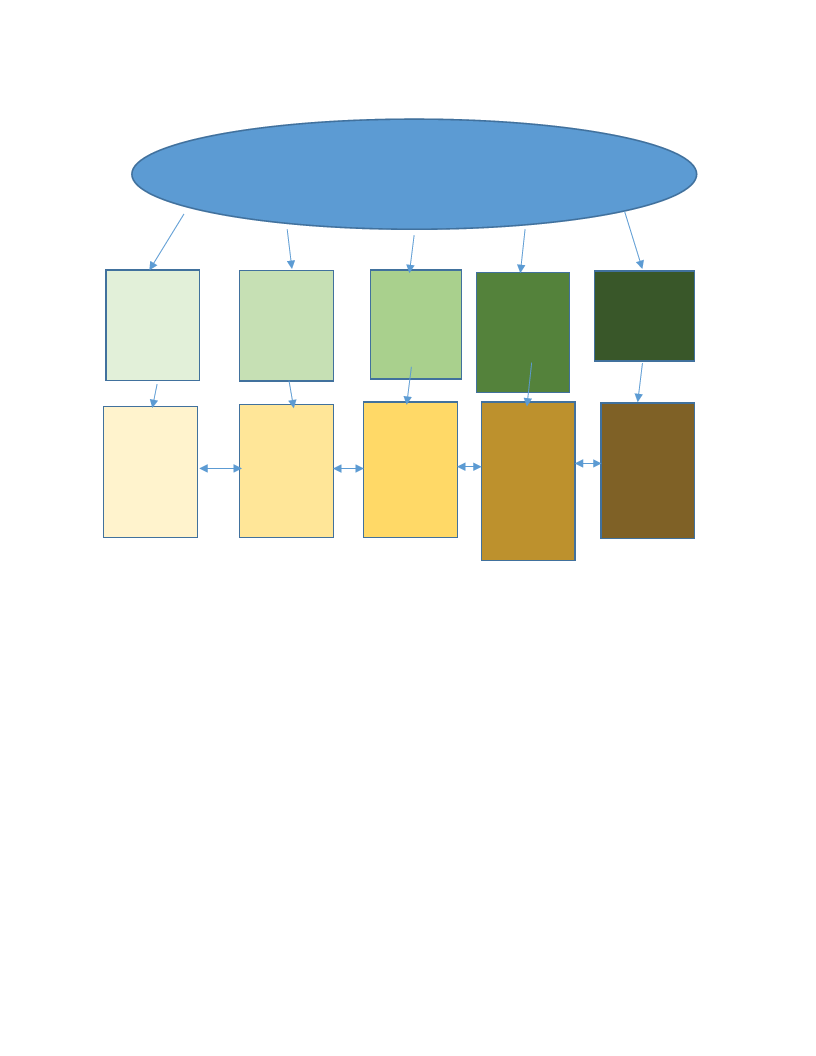
87
COMMON MENTAL STRUGGLES
OF LOW-INCOME SINGLE MOTHERS (Bussuk et al.,
1998; Rousou, Kouta, Middleton, & Karanikola; Goodman, Smyth, Borges &
Singer, 2009; McLanahan, 2004; Nomaguchi & Milkie, 2003Roshchelle, 2017)
Having a view
of a natural
setting and
gazing at it for
at 15 min
Promotes better
concentration
and focus for
problem-
solving (Kaplan
& Kaplan,1989)
Walking
outside in a
natural setting
(15-30 min
minimum)
Promotes
emotional
regulation,
communication
skills, and
stress relief
(Richardson et al.
2016)
Taking care of
houseplants at
a work space
or at home
(regularly)
Promotes
feelings of
self-esteem
(Fetherman,
2005)
Enjoying
hiking or
running
outside in
natural settings
(1/2-1 hour
minimum)
Promotes physical
health and
children’s physical
development and
bonding with
parents, decreases
depressive
symptoms (Lennon
& Scott, 2017)
Being in a
natural setting
(1/2 hour
minimum)
Promotes
feelings of
happiness,
timelessness,
peace, and
contentment
(Dougherty & Chen,
2016)
Figure 6. New model of the spectrum of self-care ecotherapy for low-income single mothers and
their children. Note the success at any of the bottom boxes promotes the wellness factors in the
other middle boxes above.
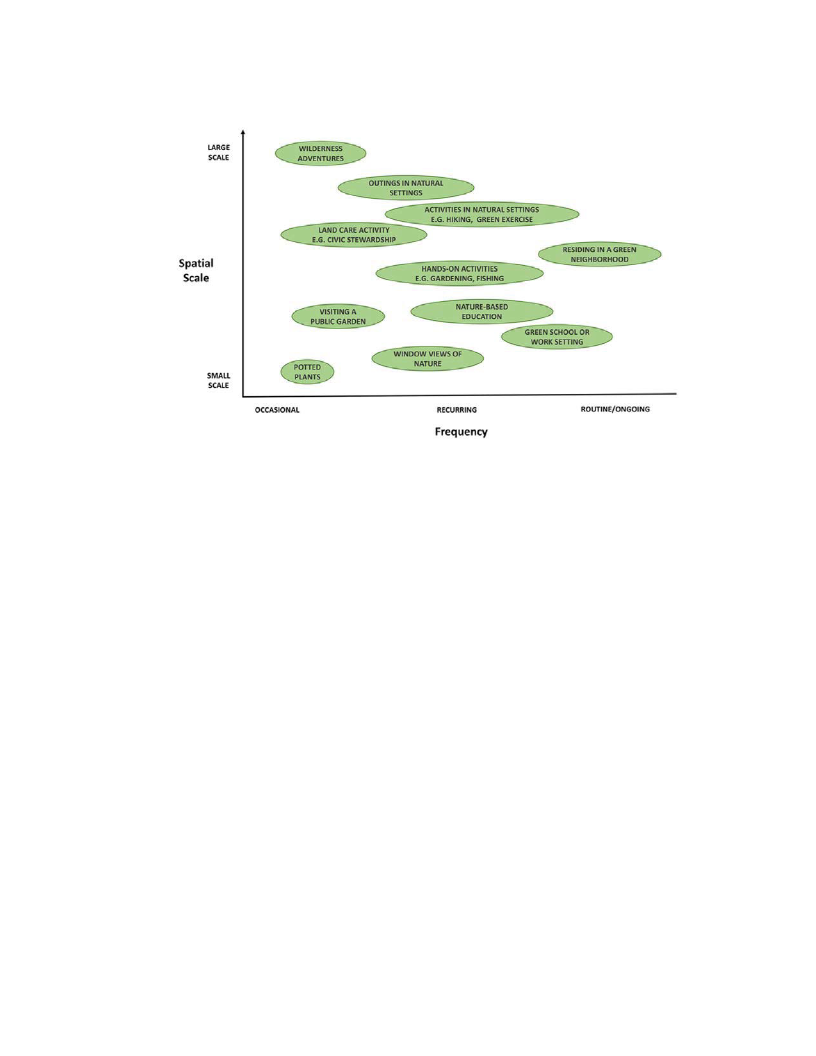
88
Figure 7. “A Spectrum of Forms of Nature Contact.” This figure from Frumkin et al. (2017)
shows potential amounts and frequency of types of nature contact. (Permission to reuse this
figure was received from the author.)

89
Discussion and Conclusions
The violence of poverty in the U.S. despite its immense resources compared to most other
countries in the world is not logical, but neither is the sexism, racism, and classism that fosters it,
and the ignorance and hatred that creates it. This project’s presentation of the lived experience
of nine case studies of low-income single women highlights a probable deep divide in the
economic, social, and mental and physical health circumstances between impoverished single
mother families, and middle and wealthy U.S. families in general.
The results of this study and literature review suggest that the cumulative effects of food
insufficiency, lack of physical safety, poor physical and/or mental health, financial distress, lack
of daycare for full-time employment, social stigma, and discrimination toward low-income
single mother populations are associated with the larger numbers of mental and physical illnesses
and social isolation in these populations. Evidence for this view has been provided in Tables 5
and 6, research interview data, as well as in past research by Broussard et al., 2012; Rousou,
Kouta, Middleton, & Karanikola; Goodman, Smyth, Borges & Singer, 2009; McLanahan, 2004;
Nomaguchi & Milkie, 2003; Steele, 1997; and Dion & Earn, 1975.
The research study performed as part of this dissertation was partially a response to
recommendations from ecopsychology researchers that more studies were needed on the effects
of nature on the mental health of certain populations. The individuals who were interviewed for
this study attempted to manage their physical and mental illnesses with self-care that included
experiencing nature alone or with their children. They all attested to the healing properties of
this natural survival strategy using various types of nature contact. Most of the types of nature
that they experienced are shown in Figures 6 and 7, which are supported by research in
ecopsychology to be healing for many people (for example, Frumkin et al., 2017; Reese &

90
Myers, 2012; Korpela, Borodulin, Neuvonen, Paronen, & Tyrväinen, 2014, Kaplan &
Kaplan,1989; Richardson, M., McEwan, K., Maratos, F., & Sheffield, D., 2016; Fetherman,
2005; Lennon & Scott, 2017; and Dougherty & Chen, 2016).
Limitations of the Research
Eight White women and one Biracial Turkish and Chaktau woman were participants in
the qualitative research project. A significantly more diverse sample would have been more
representative of the general population of low-income single mothers, since cultural percentages
reported in a current study showed that in
African American female-headed families: Nearly 2 in 5 (39.9 percent) of African
American female-headed families with children lived in poverty.
Hispanic female-headed families: More than 2 in 5 (41.9 percent) of Hispanic female-
headed families with children lived in poverty.
Native American female-headed families: Nearly half (48.4 percent) of Native American
female-headed families lived in poverty.
Asian female-headed families: Nearly 1 in 4 (24.2 percent) of Asian female-headed
families lived in poverty.
White female-headed families: More than 1 in 4 (30.6 percent) white, non-Hispanic
female-headed families lived in poverty (Tucker & Lowell (2016).
This dissertation studied low-income single mothers primarily within the dominant culture of the
U.S. White citizens due to an inability to recruit these diverse groups to participate in this study
during the recruitment time frame. Efforts were made to recruit and include diverse groups in
this study. For example, a Spanish-language recruitment poster was created and distributed
throughout the local community to recruit Latina research participants, and a volunteer Spanish
interpreter was recruited to work with the interviewer.
As Tucker & Lowell (2016) found, a much larger percentage of diverse female-headed
families (except Asian female-headed families) are poor. Their lived experience could be further
burdened not only by singlism and prejudice against low-income single mothers but also by
common discrimination within the U.S. against minority populations. Another subgroup of low-

91
income single mothers, LGBTQIA+ low-income single mothers, were also not studied in this
dissertation due to the lack of ability to recruit members of this group to participate, as well as
limited past research available about this group.
Funded research could have allowed expansion of the research sample used in this study
and made it more inclusive by allowing for more time in the participant recruitment phase of this
study to recruit diverse groups. In short, more research is recommended that would study the
effects of ecopsychology on more diverse populations of low-income single mothers with
inclusion of these groups in the research sample.
Cultural Factors in Successful Ecotherapy Interventions with Low-income Single Mothers
Individual differences and tastes amongst the general public may not be conducive to
ecotherapy because some individuals may be too fearful or not interested. Individuals with
severe allergies, or whose disability[ies] make access to the various types of nature contact more
difficult, might not benefit therapeutically from ecotherapy self-care. However, people could try
it once if they are struggling to see if it benefits them.
There may be instances where individuals may hold family-, friend-, or community-based
negative biases against the benefits of nature. Some individuals may see nature as threatening,
that nature should be made to service humankind, or may see no beauty in nature. Though this is
an atypical response, these individuals would not likely be successful using ecotherapy.
Recommendations
Greater education of human resources personnel, school principals, teachers, medical and
mental health professionals, public assistance policy makers and policy administrators, and “the
man or woman on the street” on the importance of respecting low-income single mothers of any
ethnicity would greatly aide these mothers who often feel isolated, too busy, or overlooked by
others socially and professionally. Single women can also easily fall prey to bullying by

92
neighbors and random women and men almost anywhere in a town or city in the U.S. Among
many benefits as shown in Figures 6 and 7, it is understandable why being in a natural setting
could provide a simple escape from prejudice; nature does not discriminate by gender or race in
humans. Nature could be a good equalizer, as well as peacemaker.
Greater education about self-care and ecotherapy and easier access to natural experiences
and nature contact within cities and towns in urban and rural areas could aide in the health of all
U.S. families, including low-income single mothers. Public lands administrators could educate
people in the healthy mental and physical effects of being in nature on public lands.
Greater protection of the health and welfare of these families by their communities by
whatever means necessary could possibly dramatically improve the overall high poverty rate in
the U.S. More qualitative studies with larger samples could be used to discover deeper
understanding of the causes of poverty within these populations in the form of gap analyses, risk
assessments, and other methodologies to eradicate obstacles to preventing or rising above
poverty.
Project participants recommended that more types of public or private assistance would
be beneficial to them to help them become more economically successful and help their families
become healthier overall. These suggestions included more career development programs
targeting their particular needs, childcare, secure housing, and more healthy food sources.
Further development of mandatory green spaces in both urban and rural U.S.
neighborhoods, especially with high populations of low-income families, could continue to
improve the physical and mental health, parenting, physical and mental development, economic
status, and the general wellbeing of U.S. families.

93
None of these women wanted to be seen or saw themselves as victims, but rather, as
survivors. In their determination to survive without adequate means and to endure the sacrifices
they made for their children, they surmounted or coped with various levels of success or failure
to raise their children. Witnessing their children’s successes and trials in their development and
education brought both joy and heartache to all these women, which is part of the experience of
all parents. These women who took part in this study took full responsibility for the health and
welfare of their children. To their credit, their children were their top priority, like all
responsible parents. Each woman that was interviewed had no regrets about having become a
mother despite their economic and social difficulties. From all appearances, raising their
children brought these mothers the greatest source of joy in their lives.

94
References
American Psychiatric Association, (2013). Diagnostic and statistical manual of mental disorders
(DSM-5). Washington, DC: American Psychiatric Publications.
Aud, S., Wilkinson-Flicker, S., Nachazel, T., & Dziuba, A. (2013). The condition of education
2013: Washington, DC: Government Printing Office.
Avison, W. R., Davies, L., Willson, A., & Shuey, K. (2008). Family structure and mothers’
mental health: A life course perspective on stability and change. Advances in Life Course
Research, 13, 233-255. https://doi.org/10.1016/S1040-2608(08)00009-9
Baranowska-Rataj, A., Matysiak, A., & Mynarska, M. (2014). Does lone motherhood decrease
women’s happiness? Evidence from qualitative and quantitative research. Journal of
Happiness Studies, 15(6), 1457-1477. https://doi:10.1007/s10902-013-9486-z
Bassuk, E. L., Buckner, J. C., Perloff, J. N., & Bassuk, S. S. (1998). Prevalence of mental health
and substance use disorders among homeless and low-income housed mothers. American
Journal of Psychiatry, 155(11), 1561-1564. https://doi.org/10.1176/ajp.155.11.1561
Belle, D., & Doucet, J. (2003). Poverty, inequality, and discrimination as sources of depression
among US women. Psychology of Women Quarterly, 27(2), 101-113.
https://doi.org/10.1111/1471-6402.00090
Berman, M. G., Jones, J., & Kaplan, S. (2008). The cognitive benefits of interacting with nature.
Psychological Science, 19(12), 1207-1212. https://doi.org/10.1111/j.1467-
9280.2008.02225.x
Berto, R. (2005). Exposure to restorative environments helps restore attentional capacity.
Journal of Environmental Psychology, 25(3), 249-259.
https://doi.org/10.1016/j.jenvp.2005.07.001

95
Blackwell, D. L. (2010). Family structure and children’s health in the United States: Findings
from the National Health Interview Survey, 2001-2007. Vital Health Stats, 10(246).
National Center for Health Statistics.
Broussard, C. A., Joseph, A. L., & Thompson, M. (2012). Stressors and coping strategies used by
single mothers living in poverty. Affilia: Journal of Women & Social Work, 27(2), 190-
204. doi:10.1177/0886109912443884
Brown, G. W. & Moran, P. M. (1974). Meaning, measurement and stress of life events. In B. S.
Dohrenwent and B. P. Dohrenwent (Eds.), Stressful life events: Their nature and effects.
New York: Wiley.
Budgeon, S. (2008). Couple culture and the production of singleness. Sexualities, 11(3),
301-325. https://doi.org/10.1177/1363460708089422
Budig, M. J., & England, P. (2001). The wage penalty for motherhood. American Sociological
Review, 204-225.
Bumpass, L., & Lu, H. H. (2000). Trends in cohabitation and implications for children’s family
contexts in the United States. Population Studies, 54(1), 29-41.
https://doi.org/10.1080/713779060
Burnette, C. E. (2015). Indigenous women’s resilience and resistance to historical oppression: A
case example from the United States. Affilia, 30(2), 253-258.
https://doi.org/10.1177/0886109914555215
Buzzell, L., & Chalquist, C. (2010). Ecotherapy: Healing with nature in mind. Berkeley, CA:
Counterpoint.

96
Cairney, J., Boyle, M., Offord, D. R., & Racine, Y. (2003). Stress, social support and depression
in single and married mothers. Social Psychiatry and Psychiatric Epidemiology, 38(8),
442-449. https://doi:10.1007/s00127-003-0661-0
Carlson, M. J., & Magnuson, K. A. (2011). Low-income fathers’ influence on children. The
ANNALS of the American Academy of Political and Social Science, 635(1), 95-116.
https://doi.org/10.1177/0002716210393853
Chalquist, C. (2009). A look at the ecotherapy research evidence. Ecopsychology, 1(2), 64-74.
https://doi.org/10.1089/eco.2009.0003
&KHUOLQ$&URVVဨ%DUQHW&%XUWRQ/0 *DUUHWWဨ3HWHUV53URPLVHVWKH\\FDQ
NHHS/RZဨLQFRPHZRPHQ¶VDWWLWXGHVWRZDUGPRWKHUKRRGPDUULDJHDQGGLYRUFH.
Journal of Marriage and Family, 70(4), 919-933.
Cimprich, B. (1993). Development of an intervention to restore attention in cancer patients.
Cancer Nursing, 83-92. https://doi.org/10.1111/j.1741-3737.2008.00536.x
Cohen, S. (1978). Environmental load and the allocation of attention. In A. Baum, J. E. Singer &
S. Valins, (Eds.), Advances in Environmental Psychology, Vol. 1., Hillsdale, NJ:
Lawrence Erlbaum Associates.
Corbett, C., & Hill, C. (2012). Graduating to a pay gap: The earnings of women and men one
year after college graduation. Washington, DC.: American Association of University
Women.
Crosier, T., Butterworth, P., & Rodgers, B. (2007). Mental health problems among single and
partnered mothers. Social Psychiatry and Psychiatric Epidemiology, 42(1),
6-13. https://doi.org/10.1007/s00127-006-0125-4

97
Damaske, S., Bratter, J. L., & Frech, A. (2016). Single mother families and employment, race,
and poverty in changing economic times. Social Science Research, 62, 120–133.
https://doi:10.1016/j.ssresearch.2016.08.008
DeNavas-Walt, C., & Proctor, B. D. (2015). Income and poverty in the United States.
Washington, DC, US Census Bureau.
DeNavas-Walt, C., Proctor, B. D., & Smith, J. C. (2014). Income, Poverty, and Health Insurance
Coverage in the United States: 2012. Washington, DC: US Census Bureau. 2013.
DeNavas-Walt, C., Proctor, B. D., & Smith, J. C. (2012). US Census Bureau, current population
reports, P60-243, income, poverty, and health insurance coverage in the United States:
2011. Washington, DC: US Government Printing Office.
DePaulo, B. M. (2014). A singles studies perspective on Mount Marriage. Psychological Inquiry,
25(1), 64–68. https://doi-org.antioch.idm.oclc.org/10.1080/1047840X.2014.878173
DePaulo, B. M. (2013). Marriage and happiness: 18 long-term studies. Psychology Today
website. Retrieved from //www.psychologytoday.com/blog/living-
single/201303/marriage-and-happiness-18-long-term-studies
DePaulo, B. M. (2006). Singled out: How singles are stereotyped, stigmatized, and ignored, and
still live happily ever after. New York: St Martin’s Press.
DePaulo, B. M., & Morris, W. L. (2005). Singles in society and in science. Psychological
Inquiry, 16(2-3), 57-83. https://doi.org/10.1080/1047840X.2005.9682918
Dion, K. L., & Earn, B. M. (1975). The phenomenology of being a target to discrimination.
Journal of Personality and Social Psychology, 32, 944-950.
http://dx.doi.org/10.1037/0022-3514.32.5.944

98
Doherty, T. (2016). Theoretical and empirical foundations for ecotherapy. In M. Jordan & J.
Hinds (Eds.), Ecotherapy: Theory, research and practice (pp. 12-31). New York:
Macmillan International Higher Education.
Doherty, T., & Chen, A. (2016). Improving human functioning. Ecotherapy and environmental
health approaches. In R. Gifford (Ed.), Research methods for environmental psychology
(pp. 323-343). NY: Wiley Blackwell.
Edin, K., & Kefalas, M. (2011). Promises I can keep. Berkeley, CA: University of California.
Falicov, C. J. (2014). Latino family therapy. New York: Guilford Press.
Flick, U. (2014). Mapping the field. In K. Metsler (Ed.), The SAGE handbook of qualitative data
analysis (pp. 1-18), Thousand Oaks, CA: Sage.
Fetherman, D. L. (2005). An exploration of the meaning and effects of horticultural therapy on
human health and well-being. Dissertation Abstracts International: Section B: The
Sciences and Engineering. ProQuest Information & Learning. Retrieved from
https://search-ebscohost-
com.antioch.idm.oclc.org/login.aspx?direct=true&db=psyh&AN=2005-99002-
097&site=ehost-live&scope=site
Fontenot, K., Semega, J., & Kollar, M. (2018). Income and poverty in the United States: 2017.
Washington DC: US Government Printing Office.
Frederick, T. J., Chwalek, M., Hughes, J., Karabanow, J., & Kidd, S. (2014). How stable is
stable? Defining and measuring housing stability. Journal of Community Psychology,
42(8), 964-979. https://doi.org/10.1002/jcop.21665

99
Frumkin, H., Bratman, G. N., Breslow, S. J., Cochran, B., Kahn Jr, P. H., Lawler, J. J., ... &
Wood, S. A. (2017). Nature contact and human health: A research agenda. Environmental
Health Perspectives, 125(7), 075001. https://doi.org/10.1289/EHP1663
Gault, Milli, & Cruse (2018). Investing in single mothers’ higher education: Costs and benefits
to individuals, families, and society. Washington, DC: Institute for Women's Policy
Research.
Glacken, C. J. (1967). Traces on the Rhodian Shore: Nature and culture in Western thought from
ancient times to the end of the Eighteenth Century. Berkeley: University of California
Press.
Goodman, L. A., Smyth, K. F., Borges, A. M., & Singer, R. (2009). When crises collide. How
intimate partner violence and poverty intersect to shape women’s mental health and
coping? Trauma, Violence, & Abuse, 10(4), 306-329.
https://doi.org/10.1177/1524838009339754
Gould, E., & Wething, H. (2012). US poverty rates higher, safety net weaker than in peer
countries. Economic Policy Institute, Issue Brief, 339.
Grahn, P., & Stigsdotter, U. K. (2010). The relation between perceived sensory dimensions of
urban green space and stress restoration. Landscape and Urban Planning, 94(3), 264-
275. https://doi.org/10.1016/j.landurbplan.2009.10.012
Hamilton, B. E., Hoyert, D. L., Martin, J. A., Strobino, D. M., & Guyer, B. (2013). Annual
summary of vital statistics: 2010–2011. Pediatrics, peds-2012. https://doi:
10.1542/peds2012-3769

100
Heflin, C. M., Siefert, K., & Williams, D. R. (2005). Food insufficiency and women's mental
health: Findings from a 3-year panel of welfare recipients. Social Science & Medicine,
61(9), 1971-1982. https://doi.org/10.1016/j.socscimed.2005.04.014
Kabeer, N. (2015). Gender, poverty, and inequality: A brief history of feminist contributions in
the field of international development. Gender & Development, 23(2), 189-205.
https://doi.org/10.1080/13552074.2015.1062300
Kaplan, R. (1973). Some psychological benefits of gardening. Environment & Behavior, 5, 145-
152. https://doi.org/10.1177/001391657300500202
Kaplan, R., & Kaplan, S. (1989). The experience of nature: a psychological perspective.
Cambridge: Cambridge University Press.
Kaplan, S., & Kaplan, R. (1982). Environment and Cognition. New York: Praeger.
Karmanov, D., & Hamel, R. (2008). Assessing the restorative potential of contemporary urban
environment (s): Beyond the nature versus urban dichotomy. Landscape and Urban
Planning, 86(2), 115-125. https://doi.org/10.1016/j.landurbplan.2008.01.004
Khan, S., & VanWynsberghe, R. (2008). Cultivating the under-mined: Cross-case analysis as
knowledge mobilization. Forum: Qualitative Social Research Sozialforschung, 9(1).
https://dx.doi.org/10.17169/fqs-9.1.334
Killewald, A., & Bearak, J. (2010). Is the motherhood penalty larger for low-wage women? A
comment on quantile regression. American Sociological Review, 79(2), 350-357.
https//doi:10.1177/0003122414524574
Kingston, S. (2013). Economic adversity and depressive symptoms in mothers: Do marital status
and perceived social support matter? American Journal of Community Psychology,
52(4), 359-366. https://doi:10.1007/s10464-013-9601-7

101
Knez, I., Ode Sang, Å., Gunnarsson, B., & Hedblom, M. (2018). Wellbeing in urban greenery:
the role of naturalness and place identity. Frontiers in Psychology, 9, 491.
https://doi.org/10.3389/fpsyg.2018.00491
Korpela, K., Borodulin, K., Neuvonen, M., Paronen, O., & Tyrväinen, L. (2014). Analyzing the
mediators between nature-based outdoor recreation and emotional well-being. Journal of
Environmental Psychology, 37, 1-7. https://doi.org/10.1016/j.jenvp.2013.11.003
Landrine, H., & Klonoff, E. A. (1996). The schedule of racist events: A measure of racial
discrimination and a study of its negative physical and mental health consequences.
Journal of Black Psychology, 22(2), 144-168.
https://doi.org/10.1177/00957984960222002
Laski, M. (1961). Ecstasy: A study of some secular and religious experiences. London:
The Cressett Press.
Laverty, S. M. (2003). Hermeneutic phenomenology and phenomenology: A comparison of
historical and methodological considerations. International Journal of Qualitative
Methods, 2(3), 21-35. https://doi.org/10.1177/160940690300200303
Lezak, M. D. (1983). Neuropsychological assessment. New York: Oxford University Press.
Lichter, D. T., & Crowley, M. L. (2004). Welfare reform and child poverty: Effects of maternal
employment, marriage, and cohabitation. Social Science Research, 33(3), 385-408.
https://doi.org/10.1016/j.ssresearch.2003.09.001
Llana, C. (2007). Internal political models and foreign policy in Latin America. Foreign Affairs
in Spanish, 7(4), 21-29.

102
Luhmann, M., Hofmann, W., Eid, M., & Lucas, R. E. (2012). Subjective well-being and
adaptation to life events: a meta-analysis. Journal of Personality and Social Psychology,
102(3), 592. http://dx.doi.org/10.1037/a0025948
Maeda, E., & Hecht, M. L. (2012). Identity search: Interpersonal relationships and relational
identities of always-single Japanese women over time. Western Journal of
Communication, 76(1), 44-64. https://doi.org/10.1080/10570314.2012.637539
McCartney, K., Dearing, E., Taylor, B. A., & Bub, K. L. (2007). Quality childcare supports the
achievement of low-income children: Direct and indirect pathways through caregiving
and the home environment. Journal of Applied Developmental Psychology, 28(5), 411-
426. https://doi.org/10.1016/j.appdev.2007.06.010
McLanahan, S. (2004). Diverging destinies: How children are faring under the second
demographic transition. Demography, 41(4), 607-627.
https://doi.org/10.1353/dem.2004.0033
Monea, E., & Thomas, A. (2011). Unintended pregnancy and taxpayer spending. Perspectives on
Sexual and Reproductive Health, 43(2), 88-93. https://doi.org/10.1363/4308811
Murry, V. M., Bynum, M. S., Brody, G. H., Willert, A., & Stephens, D. (2001). African
American single mothers and children in context: A review of studies on risk and
resilience. Clinical Child and Family Psychology Review, 4(2), 133-155.
https://doi.org/10.1023/A:10113811
Nepomnyaschy, L., & Garfinkel, I. (2008). Child support, fatherhood, and marriage: Findings
from the first five years of the fragile families and child wellbeing study. Asian Social
Work and Policy Review, 1, 1-20. https://doi.org/10.1111/j.1753-1411.2007.00002.x

103
Nomaguchi, K. M., & Milkie, M. A. (2003). Costs and rewards of children: The effects of
becoming a parent on adults' lives. Journal of Marriage and Family, 65(2), 356-374.
https://doi:10.1111/j.1741-3737.2003.00356.x
Orians, G. H. (1986). An ecological and evolutionary approach to landscape aesthetics. In E. C.
Penning-Rowsell & D. Lwenthal, Eds., Meanings and values in landscape (pp. 3-25).
London: Allen & Unwin.
Park, B. J., Furuya, K., Kasetani, T., Takayama, N., Kagawa, T., & Miyazaki, Y. (2011).
Relationship between psychological responses and physical environments in forest
settings. Landscape and Urban Planning, 102, 24–32.
https://doi:10.1016/j.landurbplan.2011.03.005
Passaro, J. (2014). The unequal homeless: Men on the streets, women in their place. New York:
Routledge.
Platt, J., Prins, S., Bates, L., & Keyes, K. (2016). Unequal depression for equal work? How the
wage gap explains gendered disparities in mood disorders. Science & Medicine, 149, 3.
https://doi.org/10.1016/j.socscimed.2015.11.056
Posner, M. I. & Snyder, C. R. (1975). Attention and cognitive control. In R. L. Solso, Ed.,
Information Processing and Cognition (pp. 55-85). Hillsdale, NJ; Erlbaum,
Pressman, S. (2018). The range of poverty in America. U.S. News and World Report, Sept. 12.
Retrieved from https://www.usnews.com/news/healthiest-communities/articles/2018-09-
12/poverty-in-america-new-census-data-paint-an-unpleasant-picture
Raanaas, R. K., Patil, G. G., & Hartig, T. (2012). Health benefits of a view of nature through the
window: A quasi-experimental study of patients in a residential rehabilitation center.
Clinical Rehabilitation, 26(1), 21-32. https://doi.org/10.1177/0269215511412800

104
Reese, R. F., & Myers, J. E. (2012). EcoWellness: The missing factor in holistic wellness
models. Journal of Counseling & Development, 90(4), 400-406.
https://doi.org/10.1002/j.1556-6676.2012.00050.x
Richardson, M., McEwan, K., Maratos, F., & Sheffield, D. (2016). Joy and calm: How an
evolutionary functional model of affect regulation informs positive emotions in nature.
Evolutionary Psychological Science, 2(4), 308-320. https://doi.org/10.1007/s40806-016-
0065-5
Roschelle, A. R. (2017, December). Our lives matter: The racialized violence of poverty among
homeless mothers of color. In Sociological Forum, 32, 998-1017.
https://doi.org/10.1111/socf.12365
Rousou, E., Kouta, C., Middleton, N., & Karanikola, M. (2013). Single mothers’ self-assessment
of health: A systematic exploration of the literature. International Nursing Review, 60(4),
425-434. doi:10.1111/inr.12044
Russell, K. C. (2012). Therapeutic use of nature. In S. Clayton and S. Opotow (Eds.), Identity
and the Natural Environment (pp. 428–444). Cambridge: MIT Press.
Seawright, J., & Gerring, J. (2008). Case selection techniques in case study research a menu of
qualitative and quantitative options. Political Research Quarterly, 61(2), 294-308.
https://doi.org/10.1177/1065912907313077
Semega, J. L., Fontenot, K. R., & Kollar, M. A. (2017). Income and poverty in the United States:
2016. Current Population Reports, (P60-259).
Shachar, R., Leshem, T., Nasim, R., Rosenberg, J., Schmidt, A., & Schmuely, V. (2013).
Exploring discourses that affect therapists regarding single women. Journal of Feminist

105
Family Therapy: An International Forum, 25(4), 257-280.
https://doi.org/10.1080/08952833.2013.777887doi:10.1080/08952833.2013.777887
Son, S., & Bauer, J. W. (2010). Employed rural, low-income, single mothers’ family and work
overtime. Journal of Family and Economic Issues, 31(1), 107-120.
https://doi.org/10.1007/s10834-009-9173-8
Spradley, P. (1979). The ethnographic interview. New York, NY: Harcourt, Brace, Jovanovich.
Steele, C. M. (1997). A threat in the air: How stereotypes shape intellectual identity and
performance. American Psychologist, 52, 613-629. http://dx.doi.org/10.1037/0003-
066X.52.6.613
Suarez-Orozco, M., & Páez, M. (Eds.). (2002). Latinos: Remaking America. Oakland, CA:
University of California Press.
Taylor, A. (2012). Single women in popular culture: The limits of Postfeminism. New York:
Palgrave Macmillan.
Tennessen, C. M., & Cimprich, B. (1995). Views to nature: Effects on attention. Journal of
Environmental Psychology, 15(1), 77-85. https://doi.org/10.1016/0272-4944(95)90016-0
Tjaden, P., & Thoennes, N. (2000). Prevalence and consequences of male-to-female and female-
to-male intimate partner violence as measured by the National Violence Against Women
Survey. Violence Against Women, 6(2), 142-161.
https://doi.org/10.1177/10778010022181769
Torien, M. (2016). Conversations and Conversation Analysis. In K. Metsler (Ed.), The SAGE
handbook of qualitative data analysis (pp. 327-340), Thousand Oaks, CA: Sage.
Tucker, J., & Lowell, C. (2016). National Snapshot: Poverty Among Women & Families, 2015.
Washington, DC: National Women’s Law Center.

106
Ulrich, R. S., Simons, R. F., Losito, B. D., Fiorito, E., Miles, M. A., & Zelson, M. (1991). Stress
recovery during exposure to natural and urban environments. Journal of Environmental
Psychology, 11(3), 201-230. https://doi.org/10.1016/S0272-4944(05)80184-7
U.S. Census Bureau (2014). Income and Poverty in the United States, 2014. Retrieved from
http://www.census.gov/content/dam/Census/library/publications/2015/demo/p60-252.pdf
U.S. Census Bureau (2013, August). America’s families and living arrangements: 2012.
Retrieved from https://www.census.gov/prod/2013pubs/p20-570.pdf
U.S. Census Bureau. (2019). Quick facts, Flagstaff, AZ, April 1, 2010. Retrieved from
https://www.census.gov/quickfacts/fact/table/flagstaffcityarizona/PST045218
U.S. Census Bureau (2011). Current population 2011. Annual social and economic supplement.
Retrieved from
https://www.census.gov/hhes/www/spstaples/032011/pov/new03_100_01.htm
U.S. Department of Health and Human Services (2011). Income, poverty, and health insurance
coverage in the United States: 2010. Washington, DC.
U.S. Department of Health and Human Services (2015). Office of the Secretary for Planning and
Evaluation. Retrieved from: https://aspe.hhs.gov/2015-poverty-guidelines#threshholds
Vanassche, S., Swicegood, G., & Matthijs, K. (2013). Marriage and children as a key to
happiness? Cross-national differences in the effects of marital status and children on
well-being. Journal of Happiness Studies, 14(2), 501-524.
https://doi.org/10.1007/s10902-012-9340-8
Verderber, S. & Reuman, D. (1987) Windows, views, and health status in hospital therapeutic
environments. Journal of Architectural and Planning Research, 4, 120-133.
https://www.jstor.org/stable/43029487

107
Vizenor, G. R. (2008) Survivance: Narratives of native presence. Lincoln, NE: University of
Nebraska Press.
Warren, K. J. (2015). Feminist environmental philosophy. In E. N. Zalta (Ed.), The Stanford
Encyclopedia of Philosophy. Retrieved from URL =
http://plato.stanford.edu/archives/sum2015/entries/feminism-environmental.
Wells, N. M., & Evans, G. W. (2003). Nearby nature a buffer of life stress among rural children.
Environment and Behavior, 35(3), 311-330.
https://doi.org/10.1177/0013916503035003001
Wernet, A. (2016). Hermeneutics and objective hermeneutics. In K. Metsler (Ed.), The SAGE
handbook of qualitative data analysis (pp. 234-246), Thousand Oaks, CA: Sage
Williams, K., and Harvey, D. (2001). Transcendent experience in forest environments. Journal
of Environmental Psychology. (21) 249–260. https://doi: 10.1006/jevp.2001.0204
Wise, T. (2011). White like me: Reflections on race from a privileged son. New York: Soft Skull
Press.
Woo, H., & Kelly Raley, R. (2005). A small extension to “costs and rewards of children: The
effects of becoming a parent on adults’ lives. Journal of Marriage and Family, 67(1),
216-221.
Wood, J. T., 2009. Gendered lives: Communication, gender, and culture. Boston: Wadsworth
Publishing.
Zabkiewicz, D. (2010). The mental health benefits of work: Do they apply to poor single
mothers? Social Psychiatry and Psychiatric Epidemiology, 45(1), 77-87.
https://doi.org/10.1007/s00127-009-0044-2

108
Zima, B. T., Wells, K. B. Benjamin, B., and Duan, N. (1996). Mental health problems among
homeless mothers: Relationship to service use and child mental health problems.
Archives of General Psychiatry, 53, 332-338.
https://doi:10.1001/archpsyc.1996.01830040068011
Zube, E. H., Vining, J., Law, C. s. & Bechtel, R. B. (1985). Perceived urban residential quality: a
cross-cultural bimodal study. Environment and Behavior, 17, 327-350.
https://doi.org/10.1177/0013916585173004
Zuckerman, M. (1977). Development of a situation-specific trait-state test for the prediction and
measurement of affective responses. Journal of Consulting and Clinical Psychology, 45,
513-523. https://dx.doi.org/10.1037/0022-006X.45.4.513

109
Appendix A–Participant Interview Protocol
1. Thanks for agreeing to participate in this interview as part of my research project and
dissertation. The purpose of my dissertation is to study the lived experience of single
mothers with low income and to analyze the effects of nature as a possible psychotherapeutic
tool in treating their mental health needs. For example, I will ask you generally about your
life as a single mother, and about whether your mental health may be positively or negatively
affected by your enjoyment of outdoor natural settings or decorative indoor elements, such as
indoor plants and natural views out of windows.
2. But before we talk about the possible effects of nature in your life, what can you tell me
about your life in general as a single woman with a child (or children) living on a small
income?
3. Where are you from originally?
4. What town do you currently live in?
5. How much education have you received (degrees, training?)
6. How many children do you have?
a. What age are they?
7. Do you and your family have any health issues that you feel comfortable sharing with me
about?
8. If you feel comfortable sharing, have you ever been married?
a. How many times?
9. If you are comfortable talking about it, what is your relationship with the child or your
children’s father like?

110
10. Do you believe this your relationship (or lack of relationship) with the father of your
child/children affect(s) you and how you parent?
a. How? In what ways?
b. Can you give me an example?
11. Would it be okay with you to talk about your employment status?
a. Part time? Full time?
b. Work from home?
c. Unemployed?
d. Are you happy with your employment status?
e. In what ways, if any, does being a single mother affect your employment status? How
about having low income?
f. Do you think this affects your employment, and if so, in what ways?
12. If you feel like talking about it, what has your experience regarding housing?
a. Is it or has it been stable?
13. If you feel okay talking about it, what is your experience regarding finances?
14. If you wish to share about this, what is your experience regarding family and extended
family?
15. If you feel comfortable sharing about this, what is your experience regarding the legal
system? In other words, have you had any legal issues that you feel like sharing with me
about?
16. If you have don’t mind talking about this, what is your ethnic background?
a. To what extent do you believe that cultural background and ethnicity play a part in
your experience as a single mother?

111
17. What benefits and/or obstacles have you noticed as a single mother?
18. What have you observed to be your biggest stressors as a single mother?
19. Who do you rely on for support?
20. So, switching now to the topic of nature, you’ve told me you enjoy nature.
a. What types of nature to you enjoy?
b. Do you have a favorite?
c. How often?
d. Do you bring your child/children?
e. How do you think experiencing this nature affects you and your children?
21. Is there anything else you would like to share with me about your experience as a single
mother?

112
Appendix B—Poster Used to Recruit Research Participants

113
Appendix C—Permissions to Reuse Figures and Table from Authors
Tables 1 and 2

114
Table 3
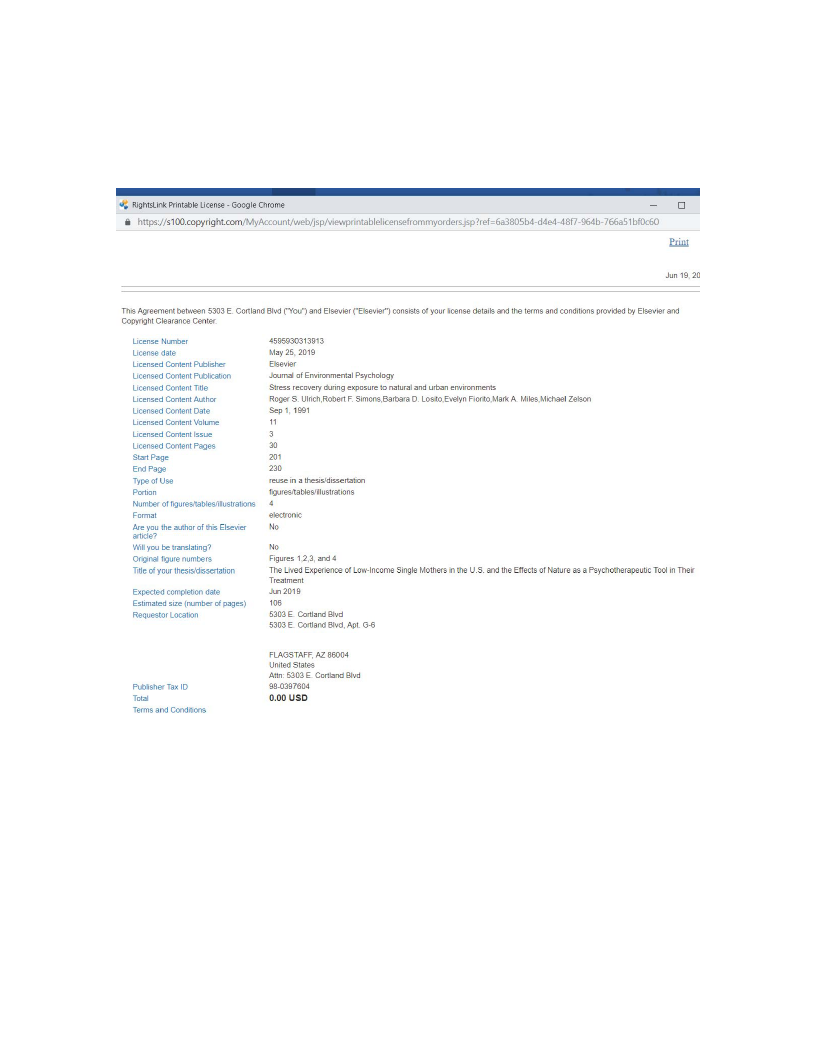
115
Figures 1, 2, 3, and 4

116
Figure 7
